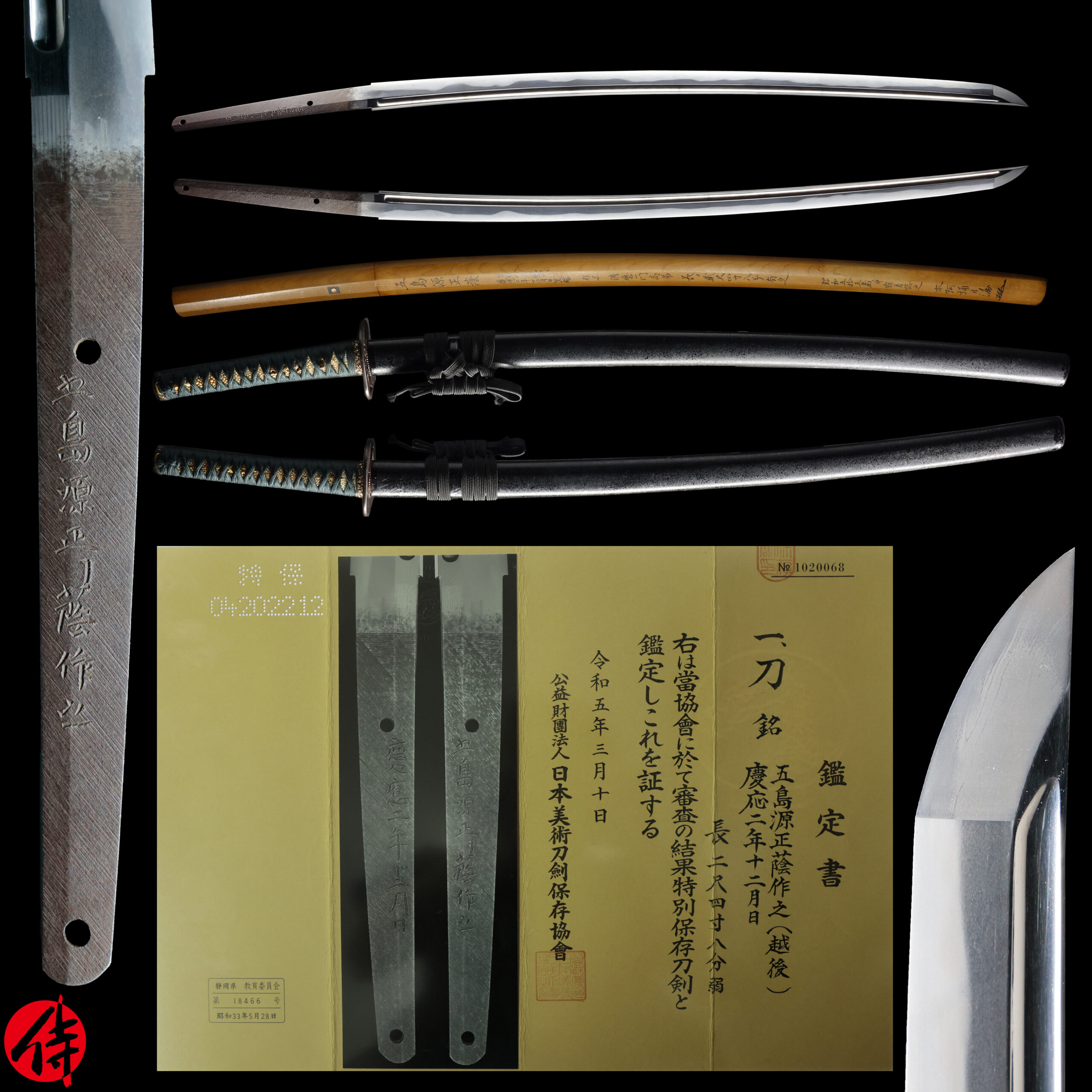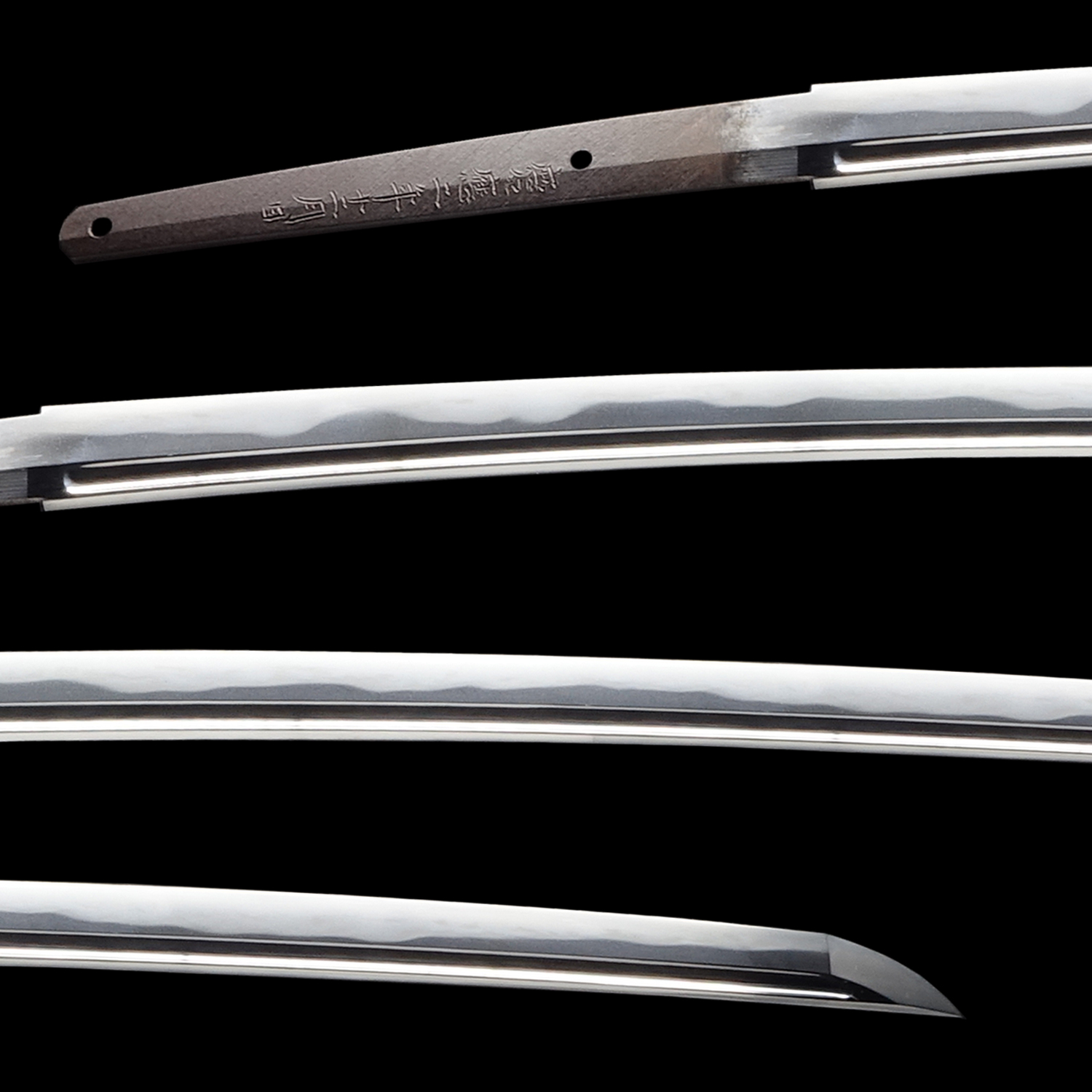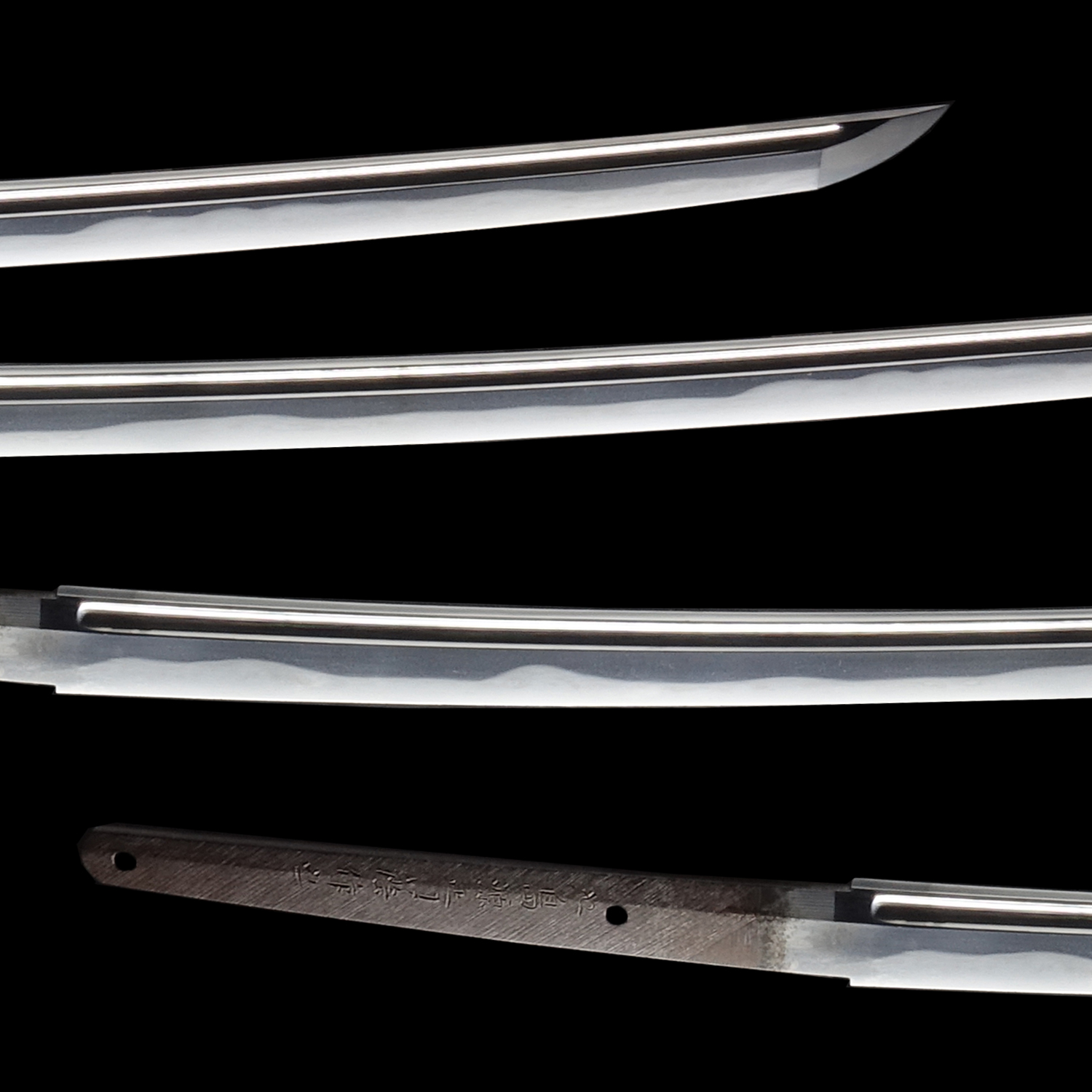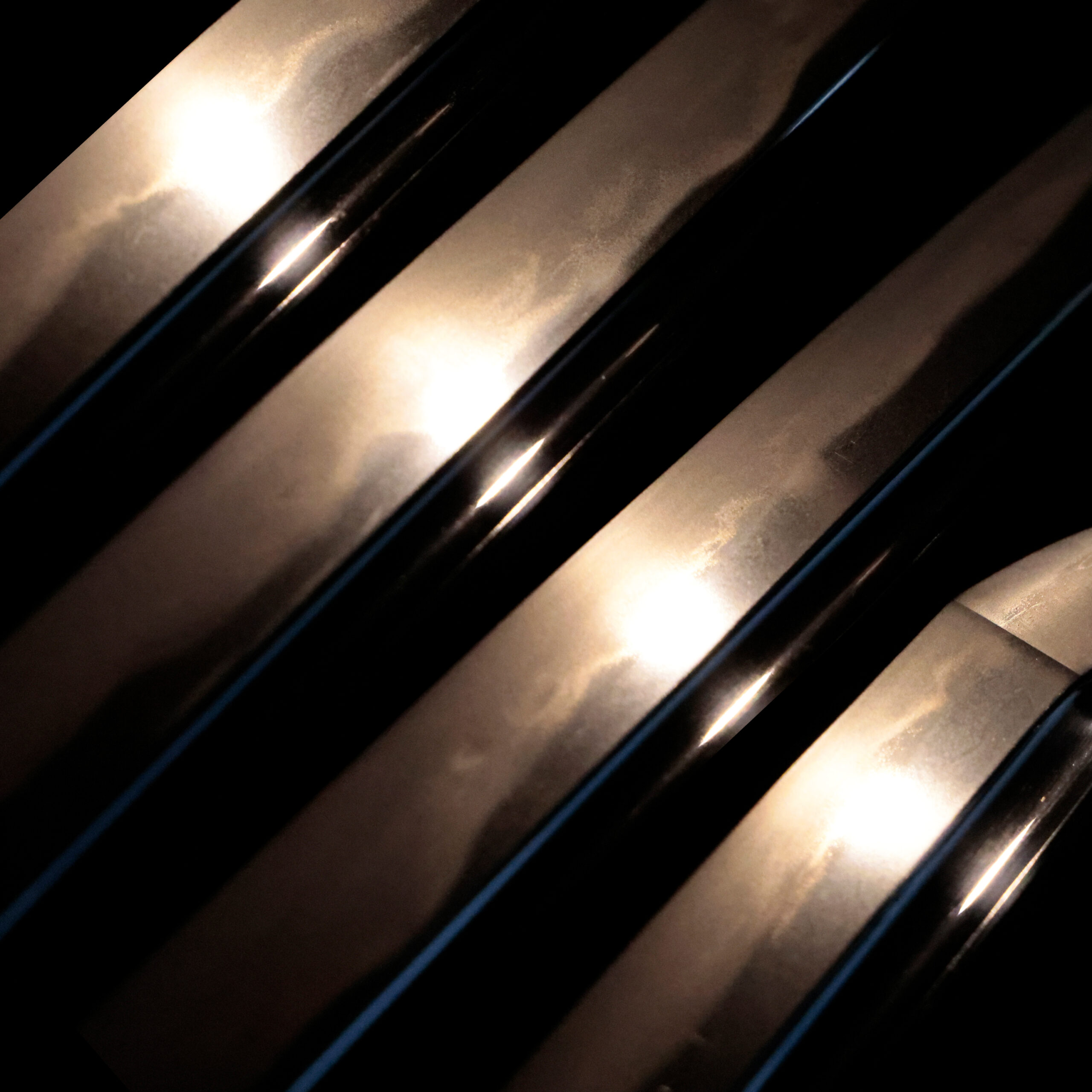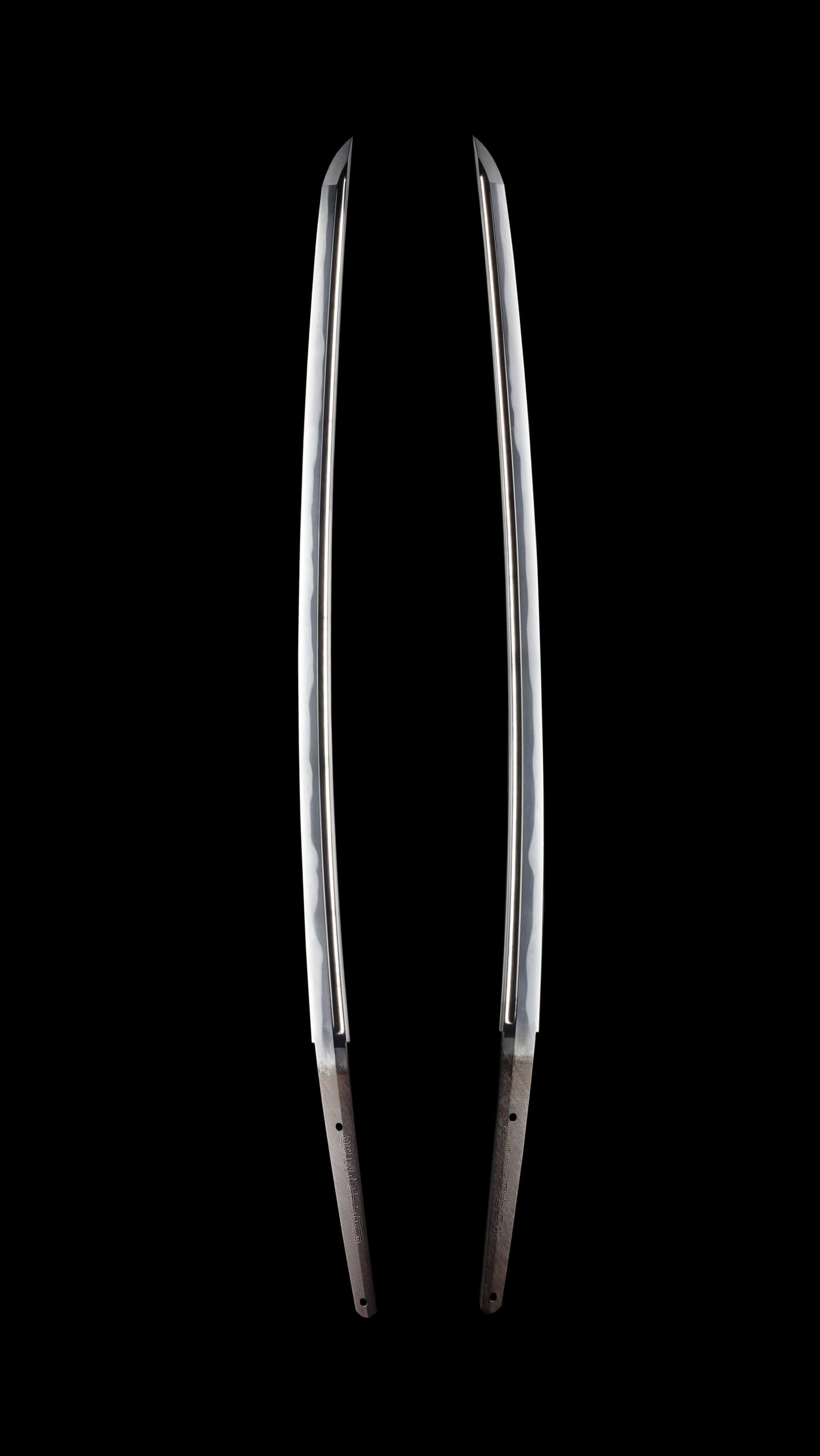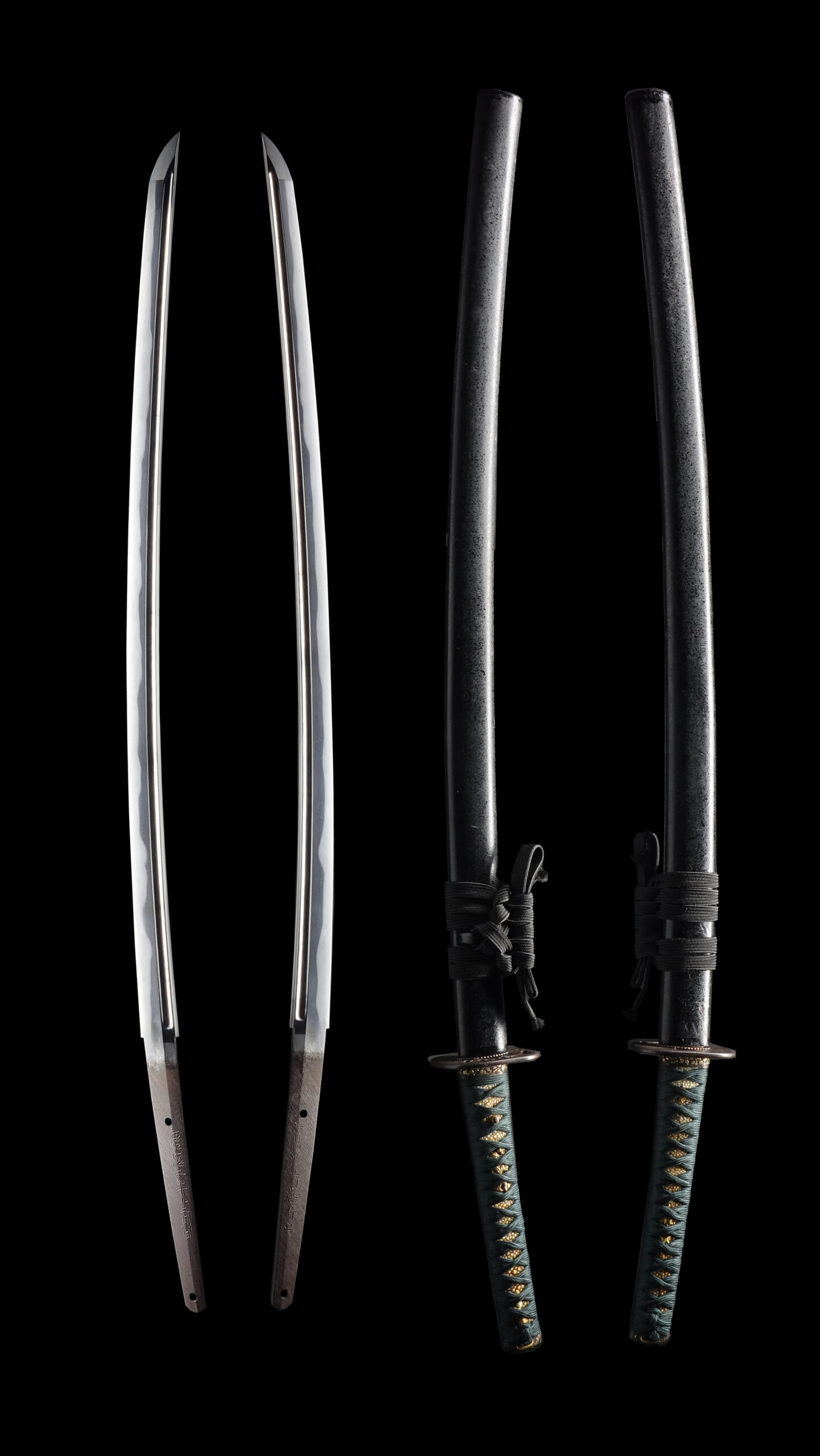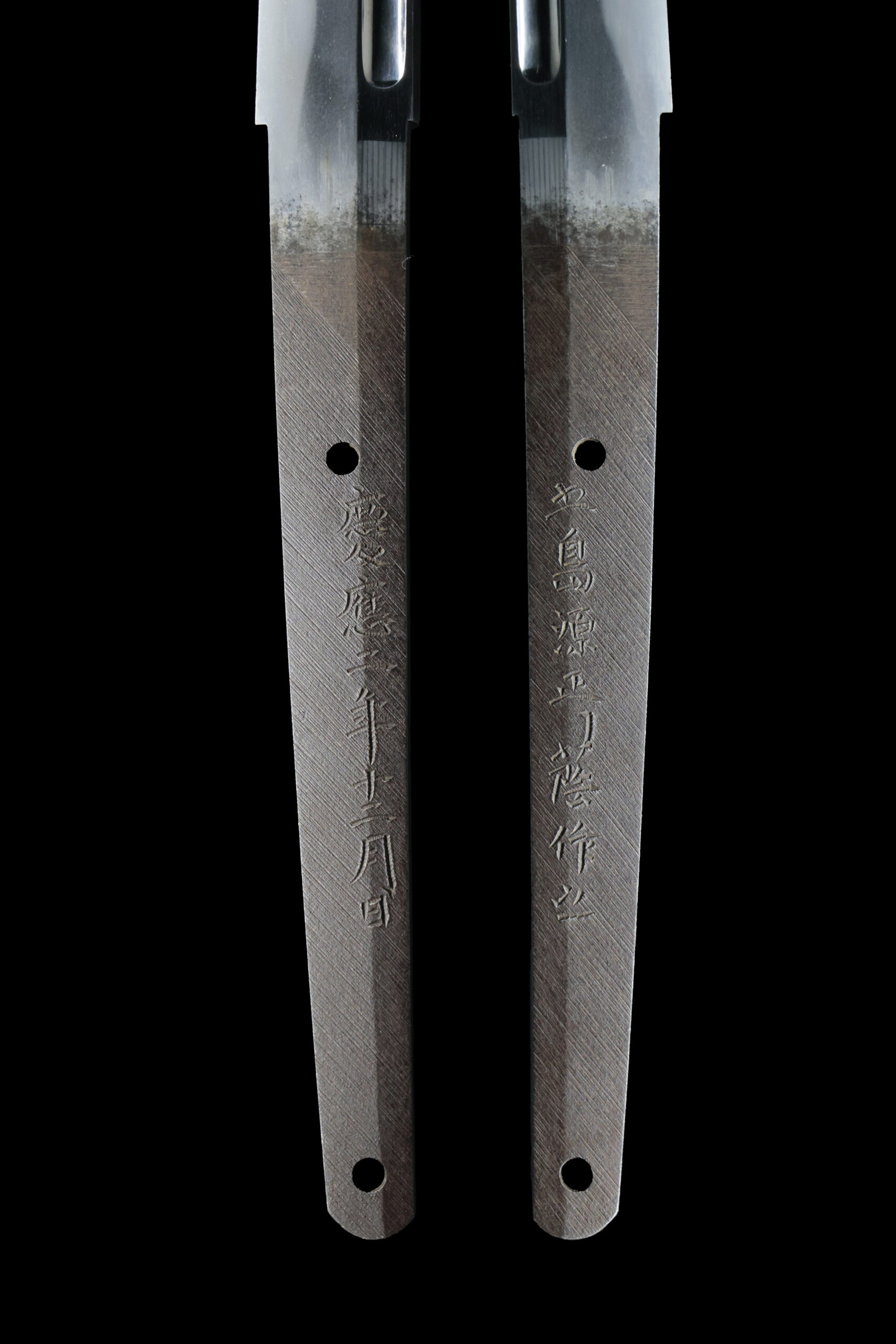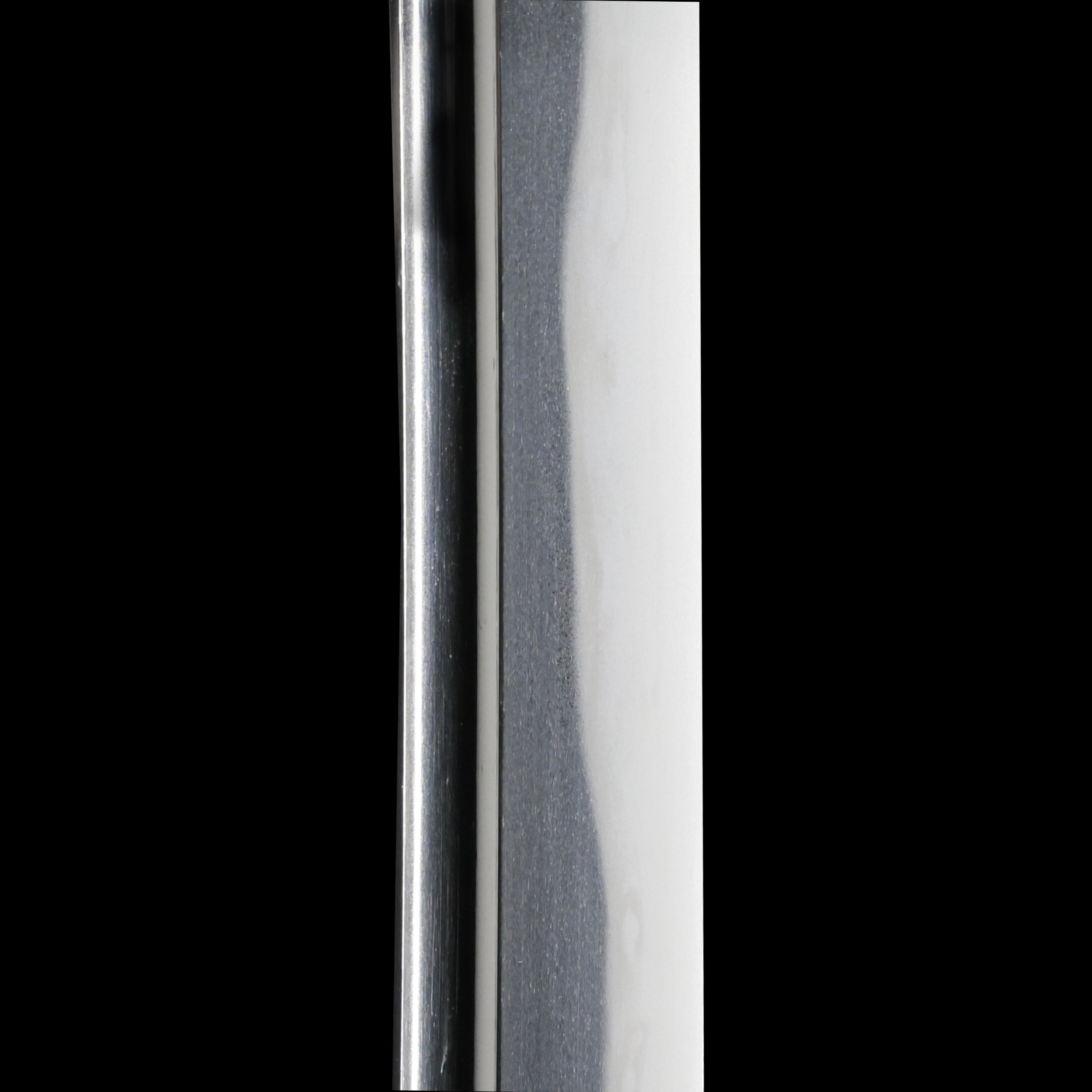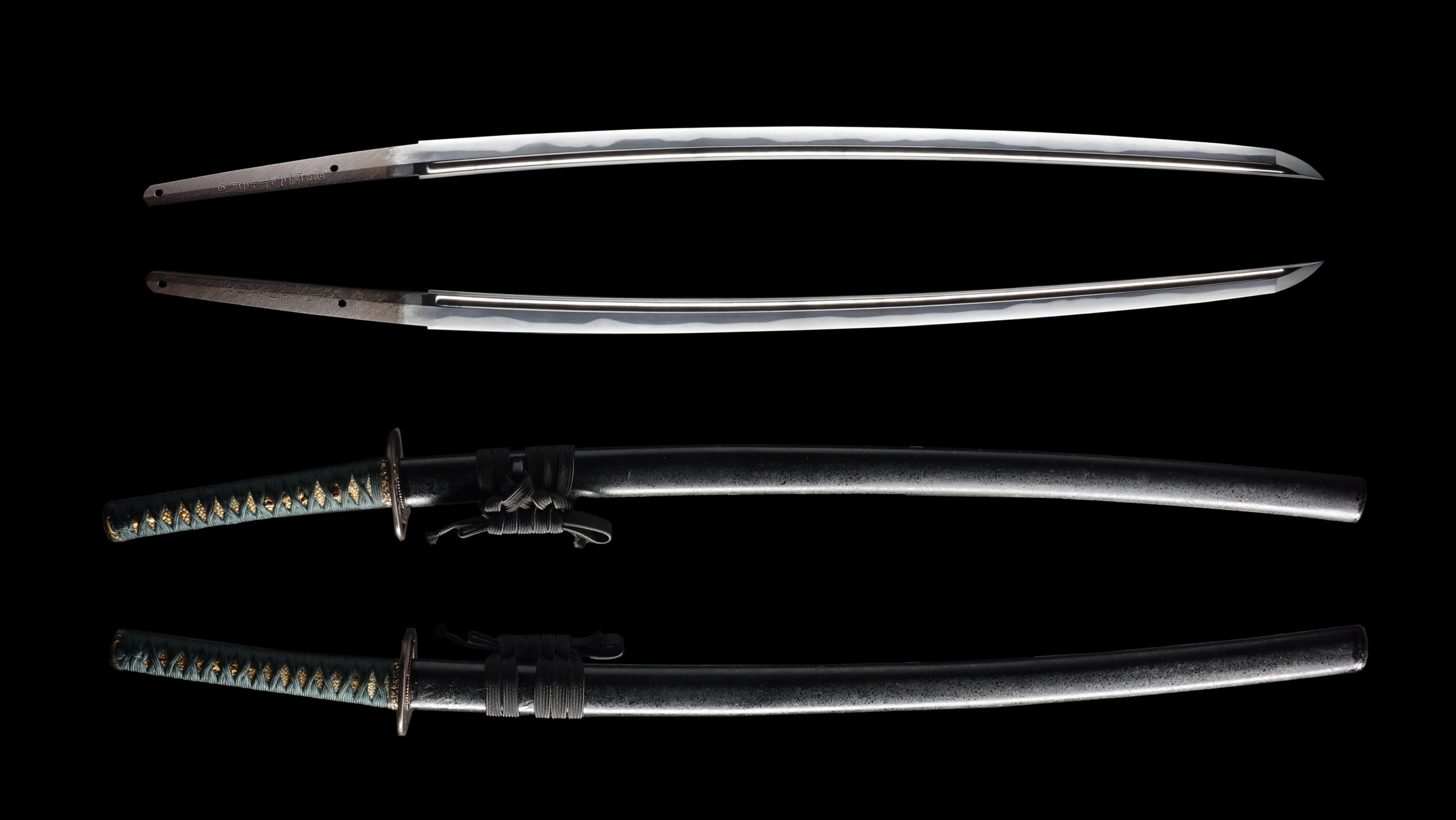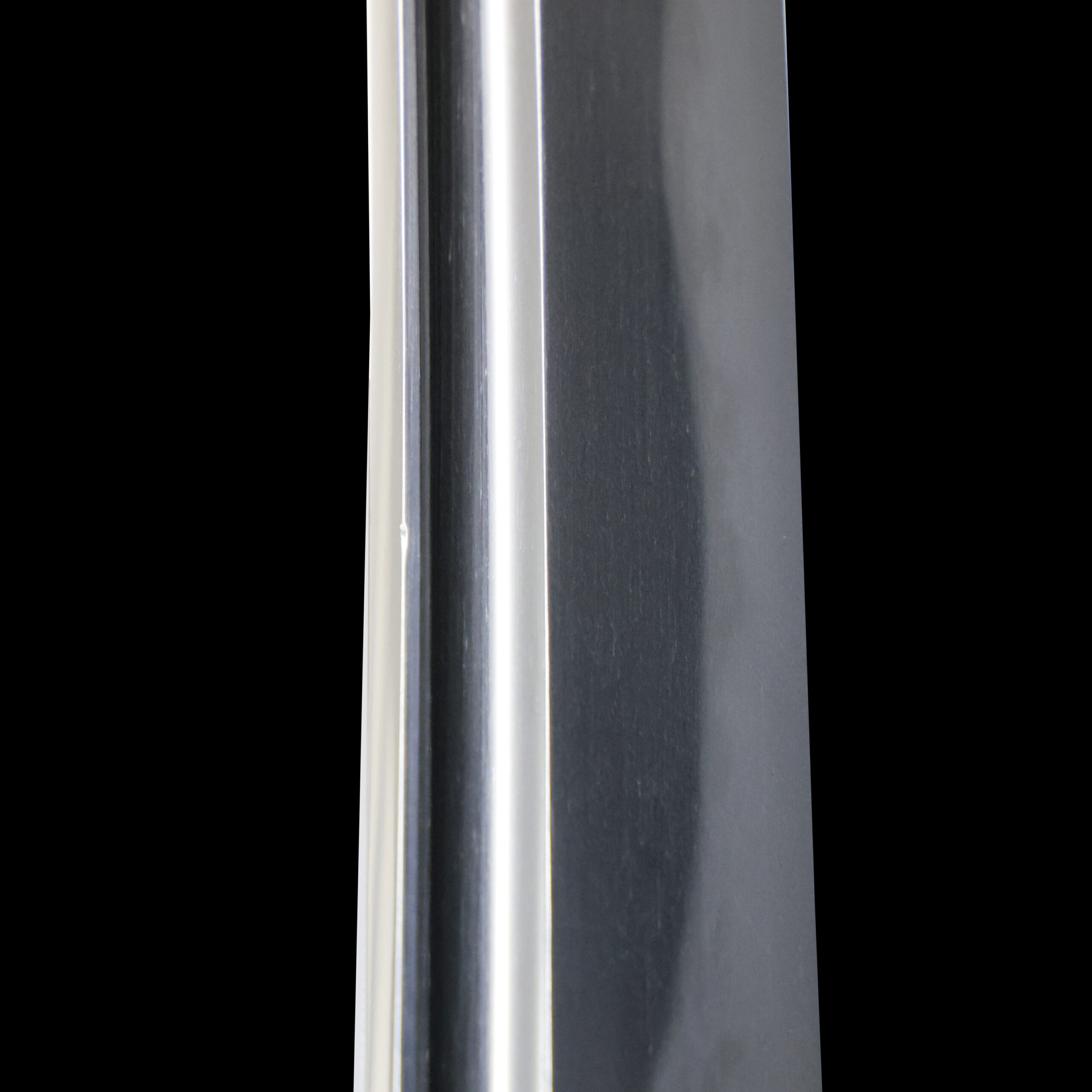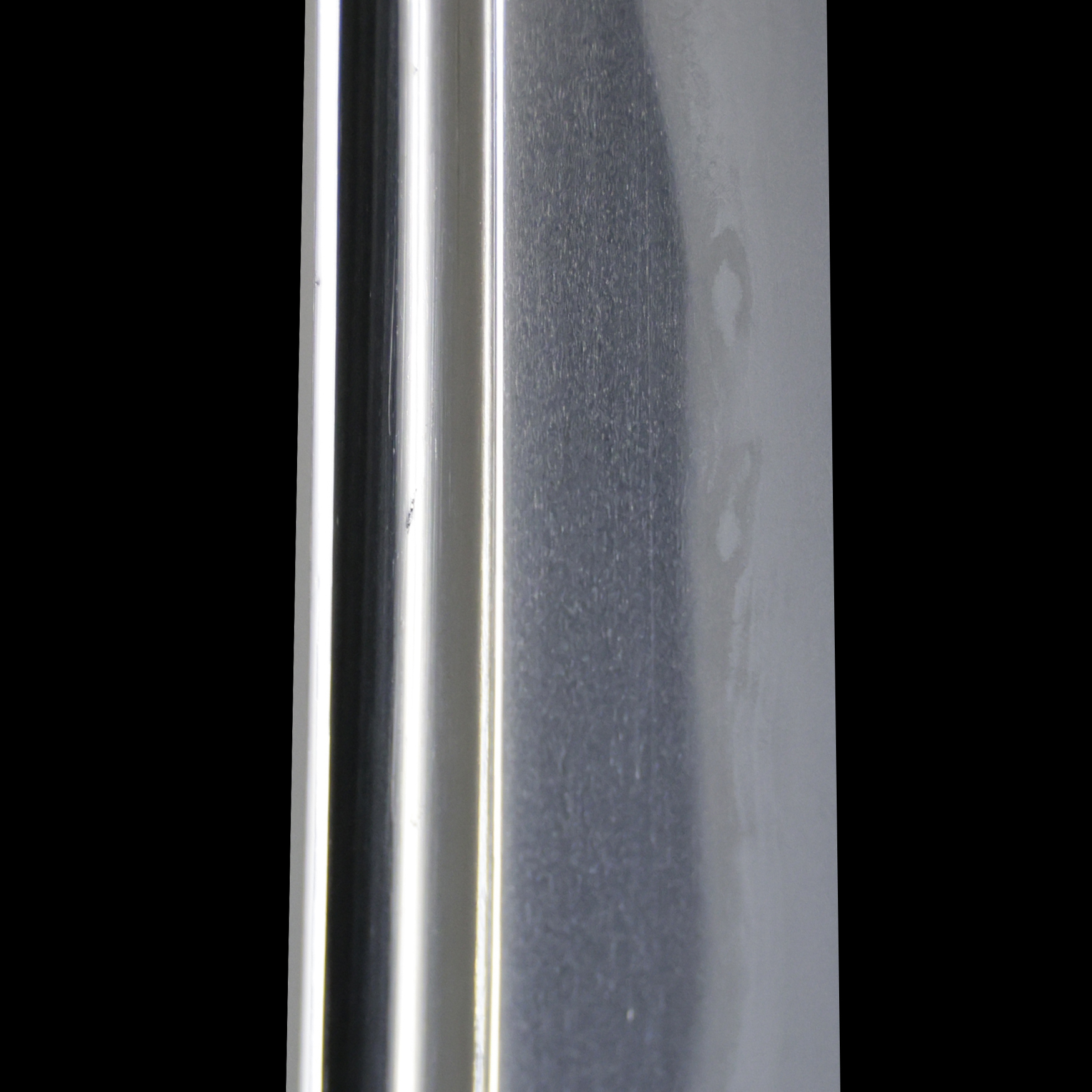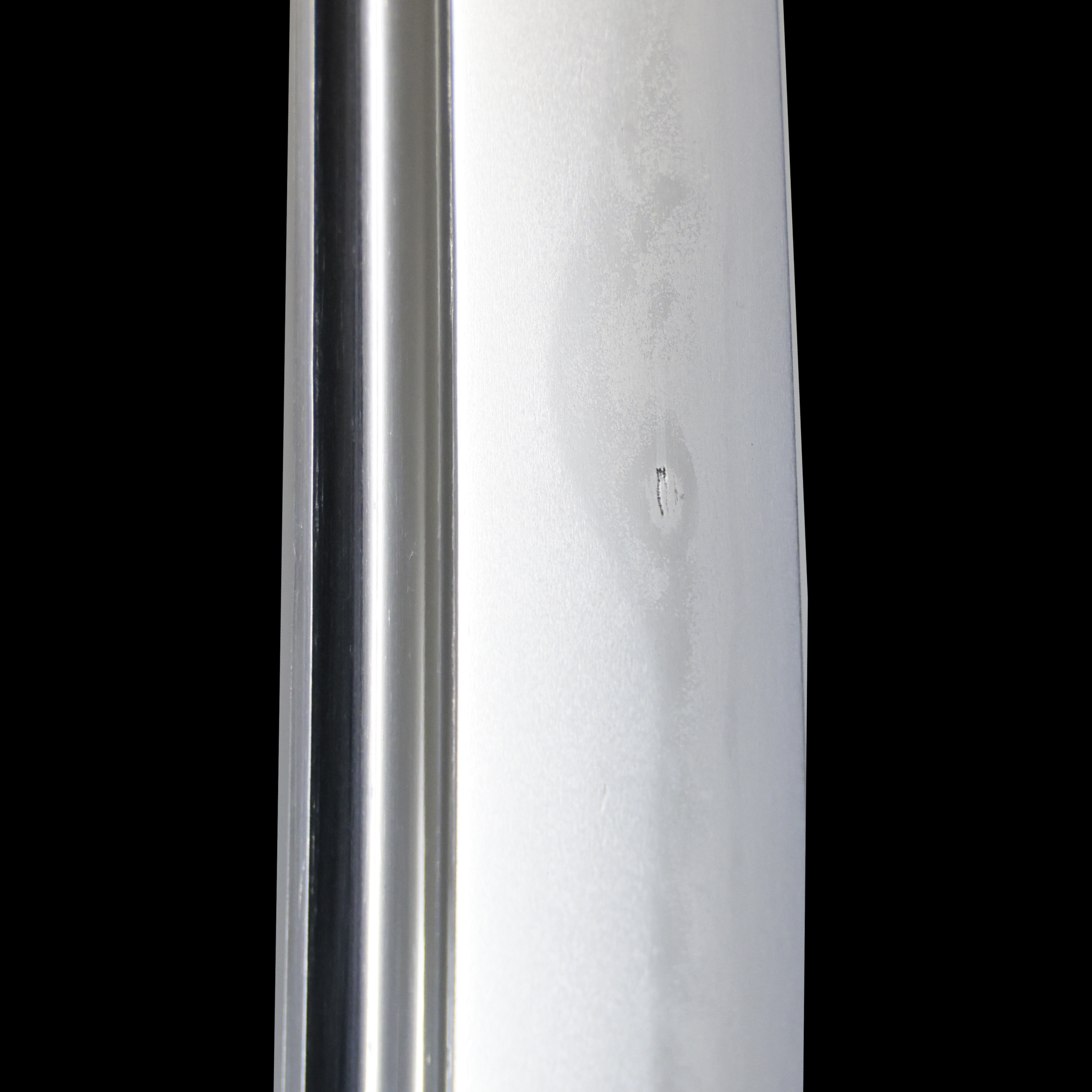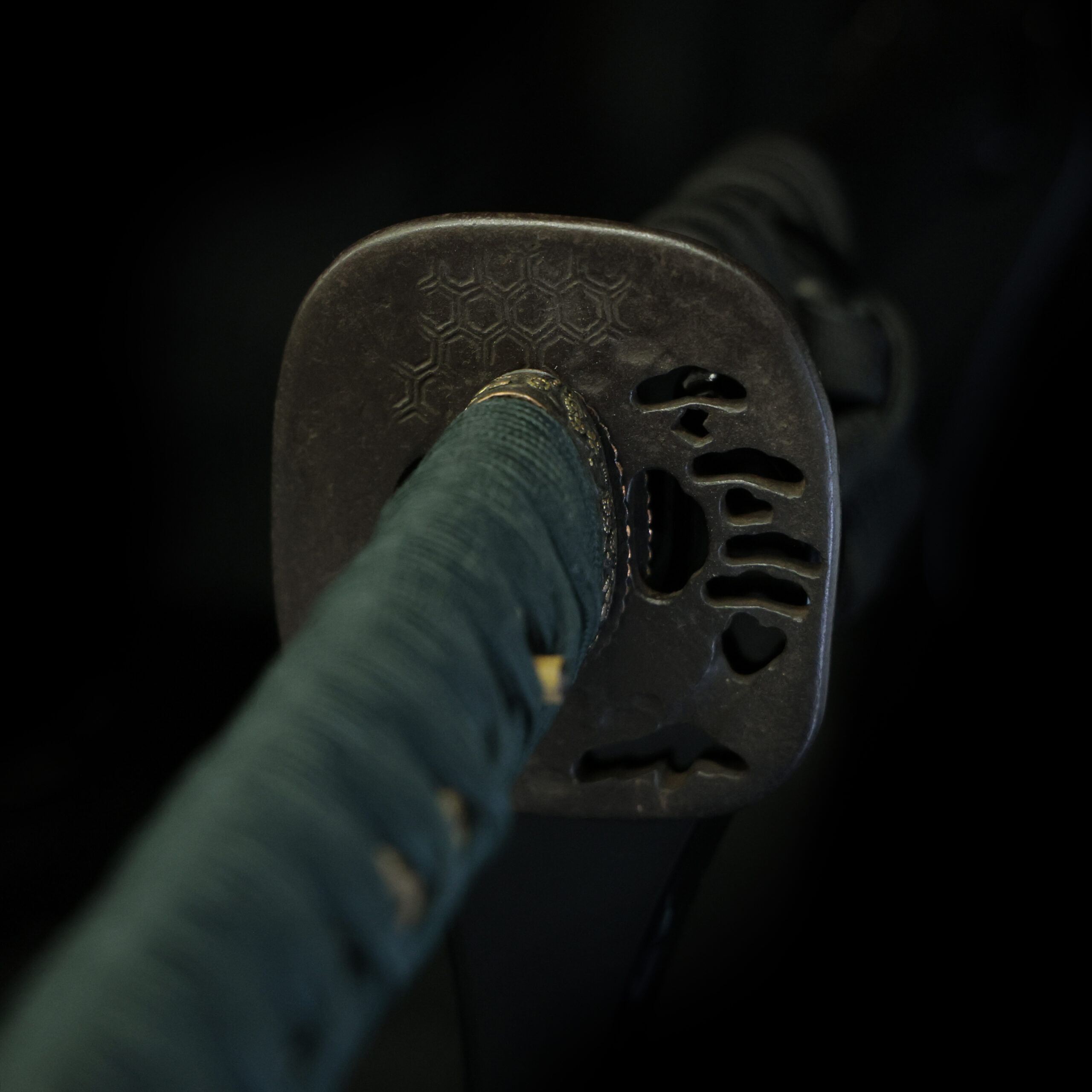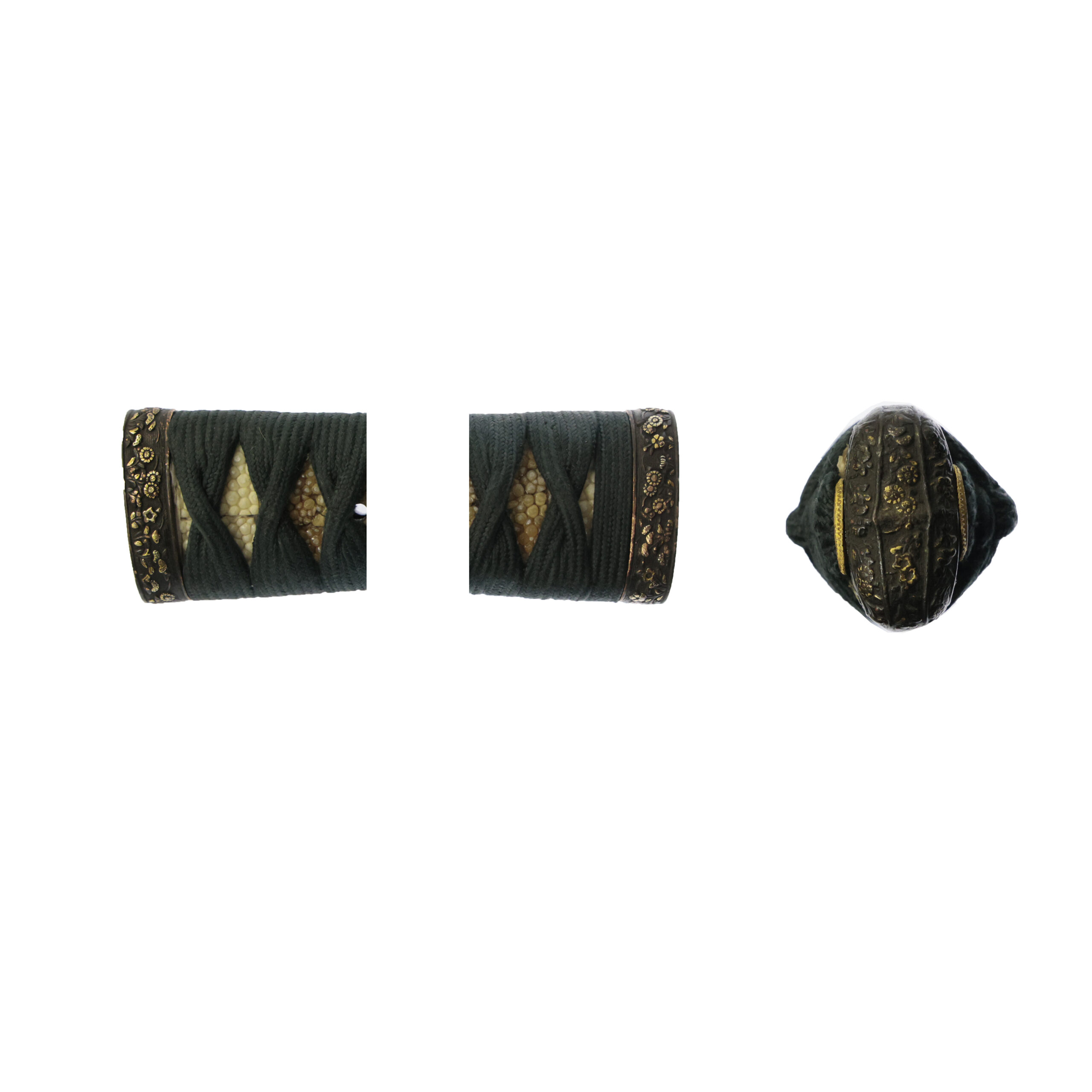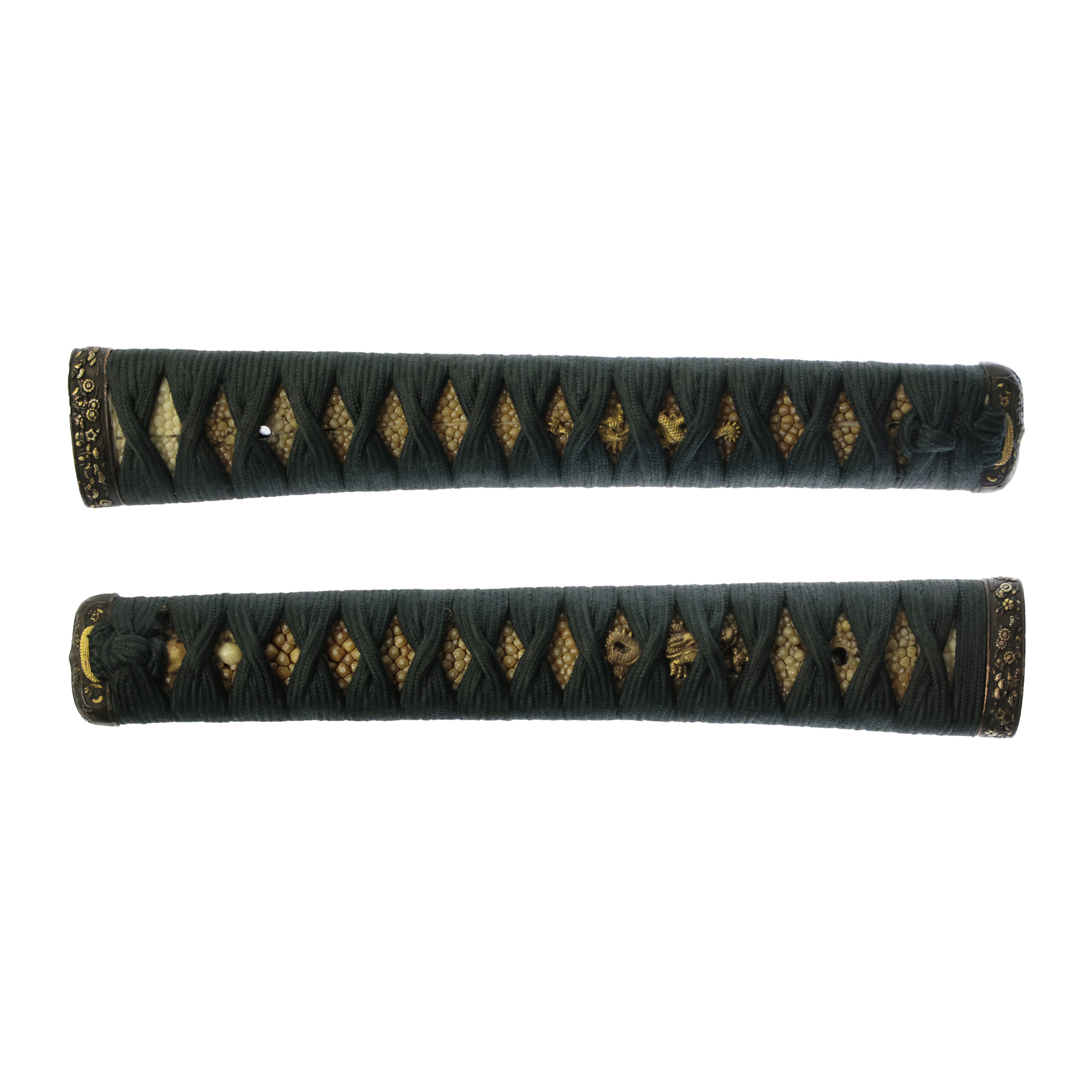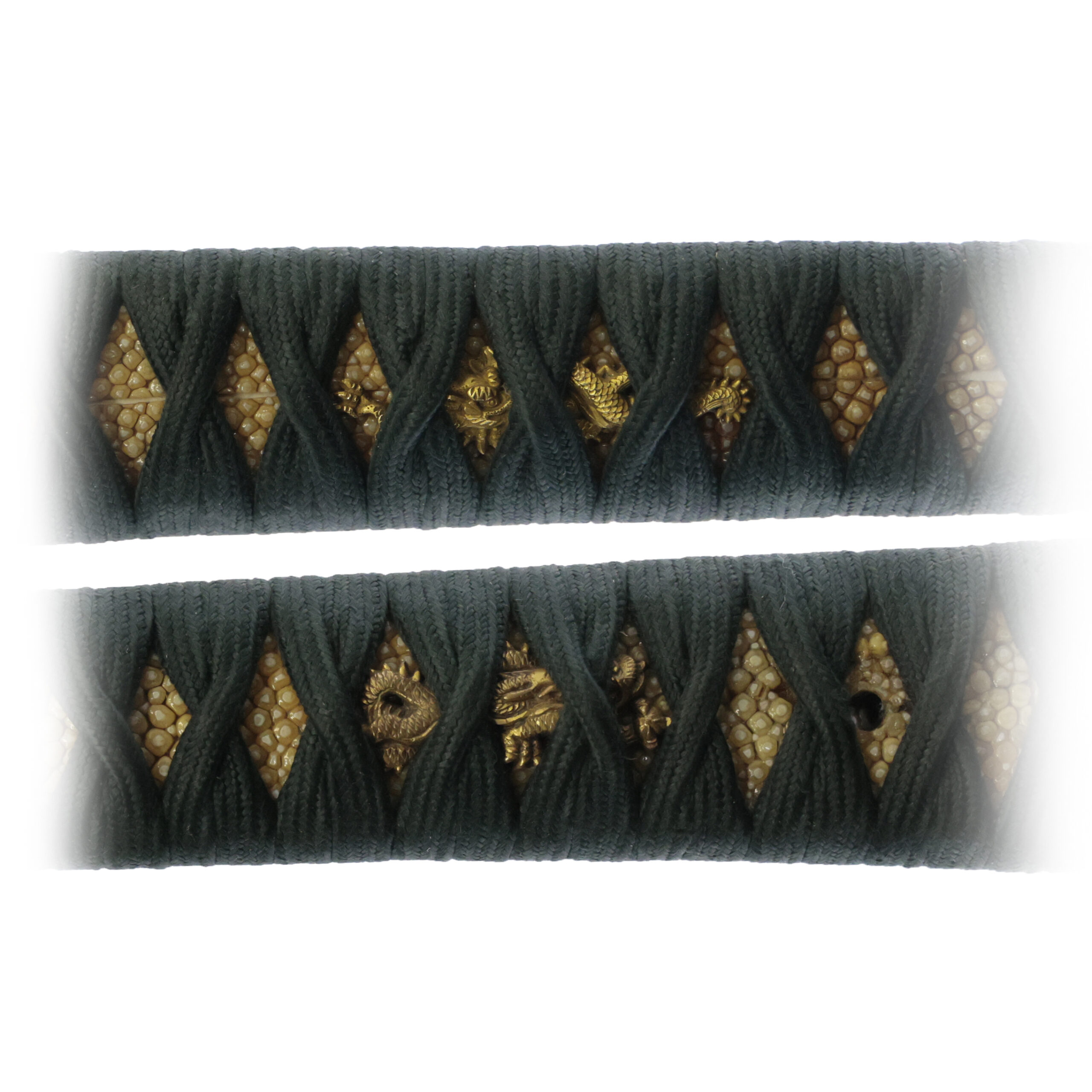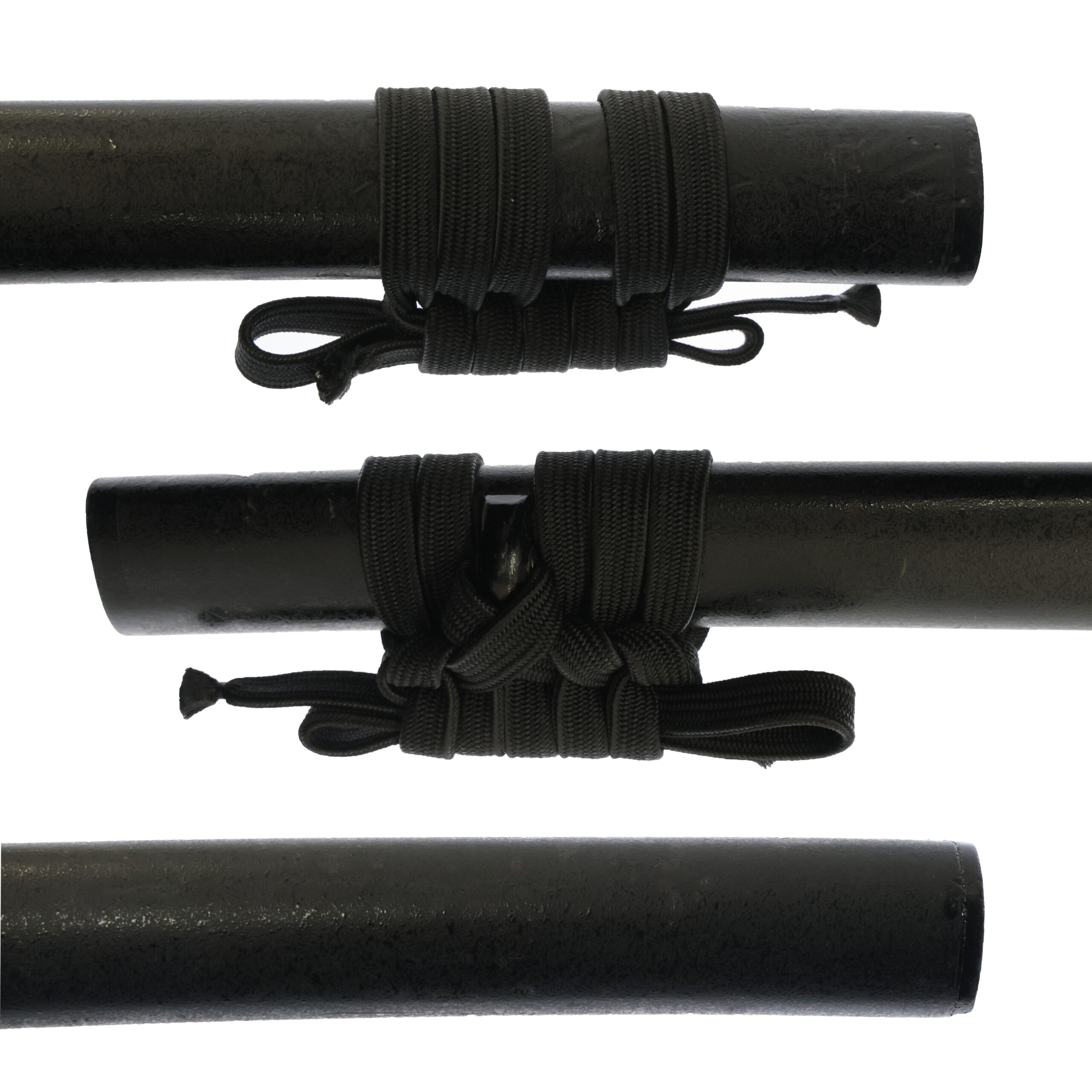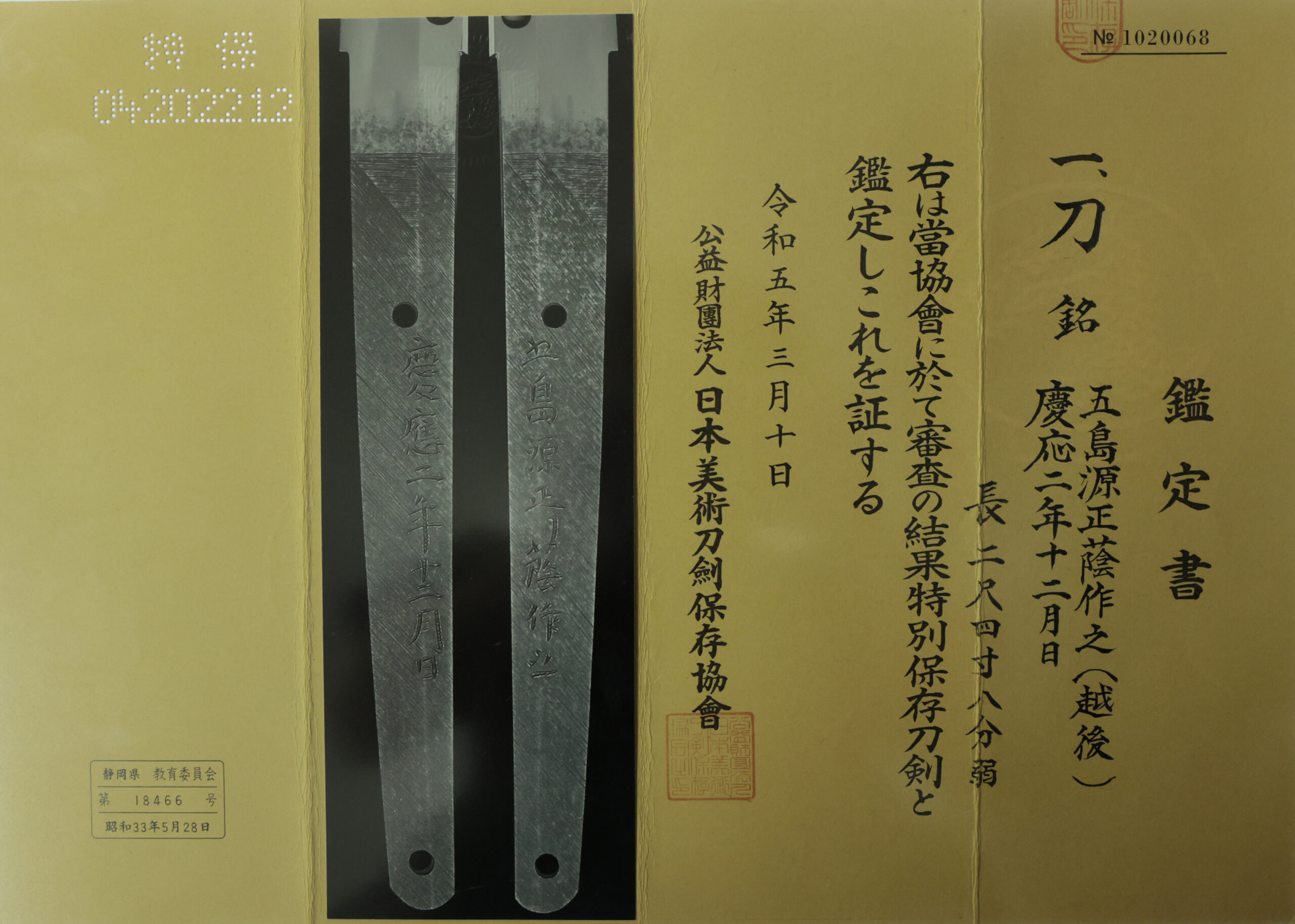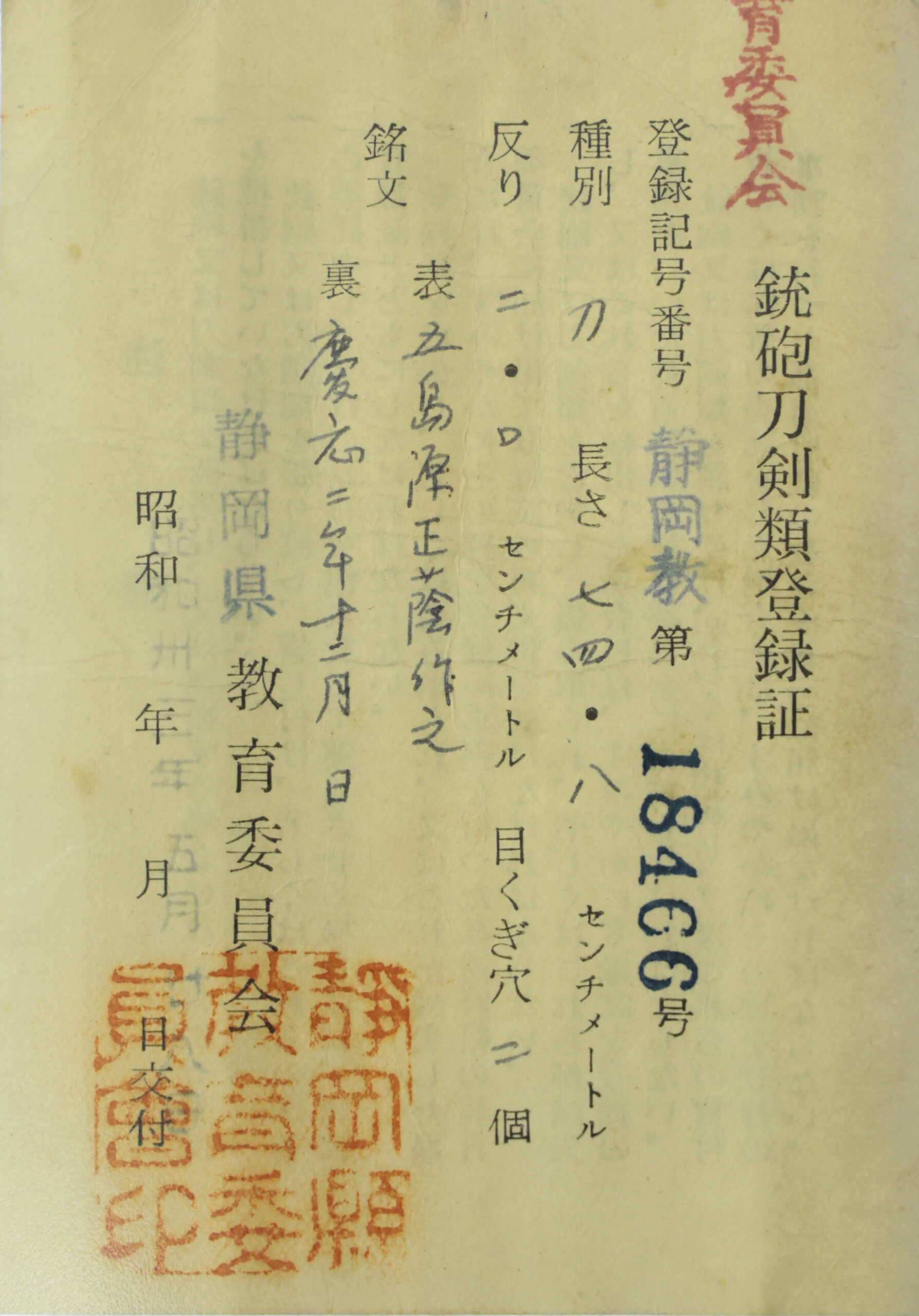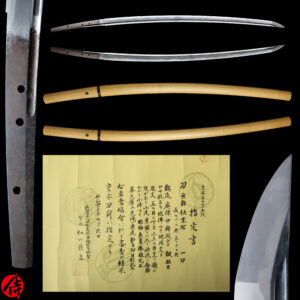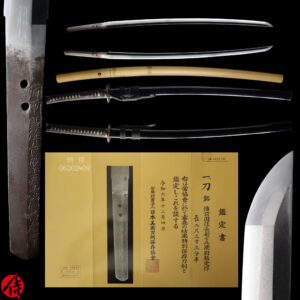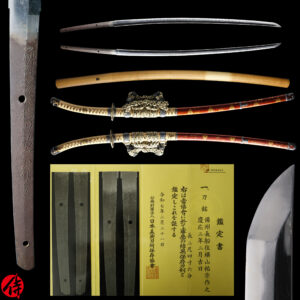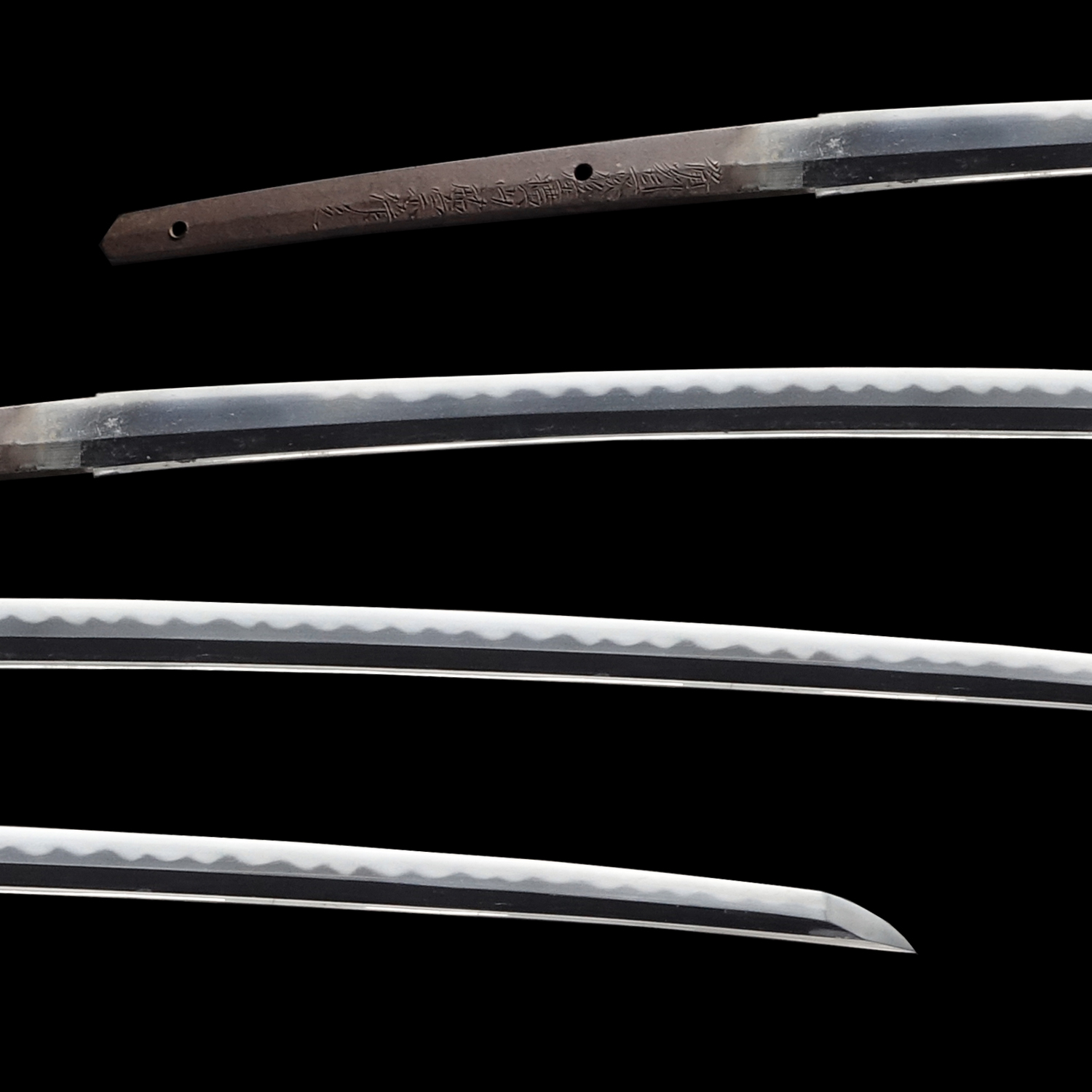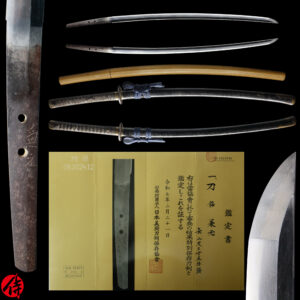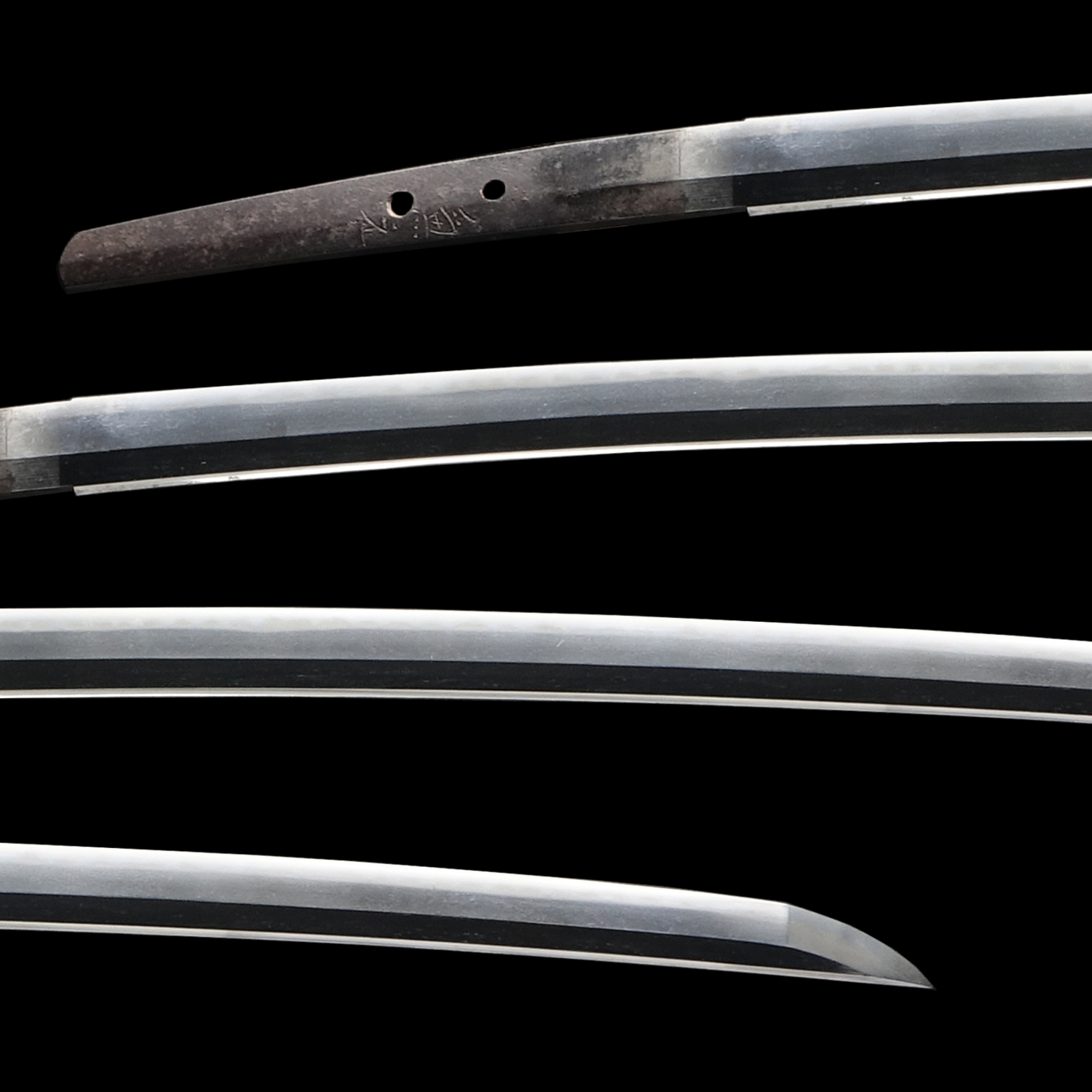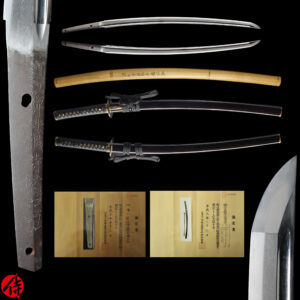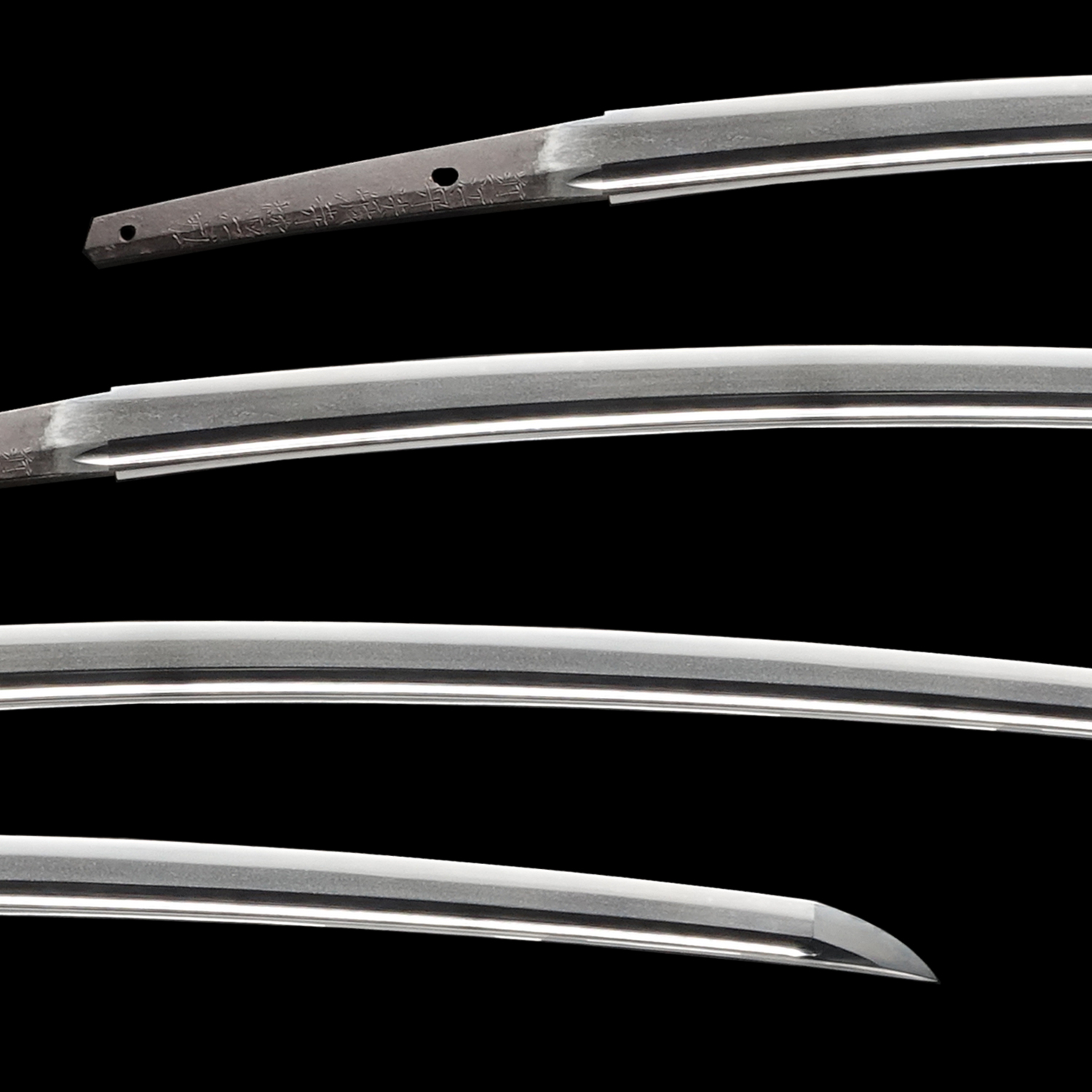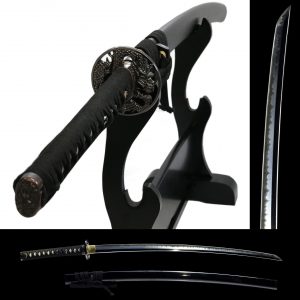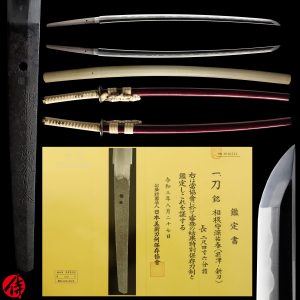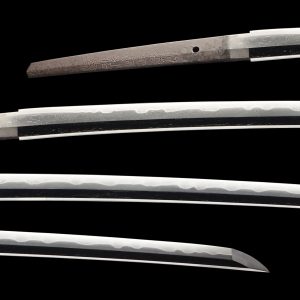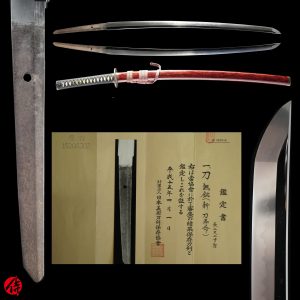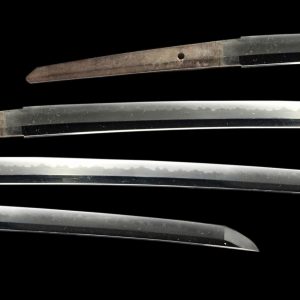Antique Japanese Sword Katana Signed by Minamoto no Masakage with Tokubetsu Hozon Certificate
【Description】
This blade was forged in December 1866 (the 2nd year of the Keio era) by Gotou Minamoto no Masakage (五島源正陰).
Masakage was a disciple of Masao Minamoto (also known as Suzuki Masao), a distinguished student of the famous late Edo master Minamoto Kiyomaro, making Masakage effectively Kiyomaro’s grand-disciple. Born as Gotou Koisuke in Etchū Province (today’s Toyama Prefecture), he first studied under Masao in Edo and later refined his skills under Suishinshi Masatsugu. He eventually established his forge in Takada Castle town (Echigo Province), producing blades that met the high demand during the turbulent Bakumatsu era. Masakage is categorized as a swordsmith of the Kiyomaro school; however, with the Meiji government’s prohibition of swords, he had no choice but to abandon his career as a swordsmith.
His signatures include “Minamoto no Masakage,” “Masakage,” “Gyokushinsai Masakage Saku,” and “Gotou Minamoto Masakage.” Inheriting the brilliant style of the Kiyomaro lineage, Masakage’s swords are regarded as fine works with great potential value for future generations.
Minamoto Kiyomaro — The “Yotsuya Masamune”
Minamoto Kiyomaro (源清麿, 1813–1855) is remembered as one of the most outstanding swordsmiths of the late Edo period, often regarded as the greatest master of the Bakumatsu era. He was born into a gōshi (郷士, farmer-samurai) family in Akaiwa village, Komoro domain (present-day Tōmi City, Nagano Prefecture). His real name was Yamaura Kurōsuke Tamaki.
Kiyomaro first studied under his elder brother, Yamaura Saneo, before moving to Edo, where he entered the dojo of Kubota Sugane, a martial arts instructor. Kubota soon recognized his true talent in swordsmithing and encouraged him to dedicate himself fully to the craft. Kiyomaro studied ancient masterpieces directly, borrowing swords from retainers, and strove to recreate practical, battle-ready blades.
He strongly embraced the Revivalist Sword Theory (刀剣復古論, Token Fukko Ron), introduced by Suishinshi Masahide in 1826. This movement called for a return to the robust and practical forms of Kamakura-period blades, in contrast to the straighter and less powerful styles of his own day. The influence of this theory was so profound that Japanese swords are now historically divided into “Shintō” (New Swords, pre-Masahide) and “Shinshintō” (New New Swords, post-Masahide).
Together with Suishinshi Masahide and his disciple Taikei Naotane, Kiyomaro came to be celebrated as one of the “Three Great Edo Masters (Edo Sansaku).” He later established his forge in Yotsuya, Edo, where he developed a distinctive style that fused elements of the Sōshū-den and Bizen-den traditions. His blades, with their brilliant nie activity and bold, majestic form, were considered so remarkable that he was hailed as the “reincarnation of Masamune,” earning him the enduring nickname “Yotsuya Masamune.”
Tragically, Kiyomaro’s life ended in suicide at the age of 42, following a decline brought on by heavy drinking. Despite his short life, his dramatic story and extraordinary craftsmanship cemented his place in history. Today, Kiyomaro’s swords remain among the most highly prized works on the market, admired as masterpieces that embody both the artistry and the spirit of the Bakumatsu era.
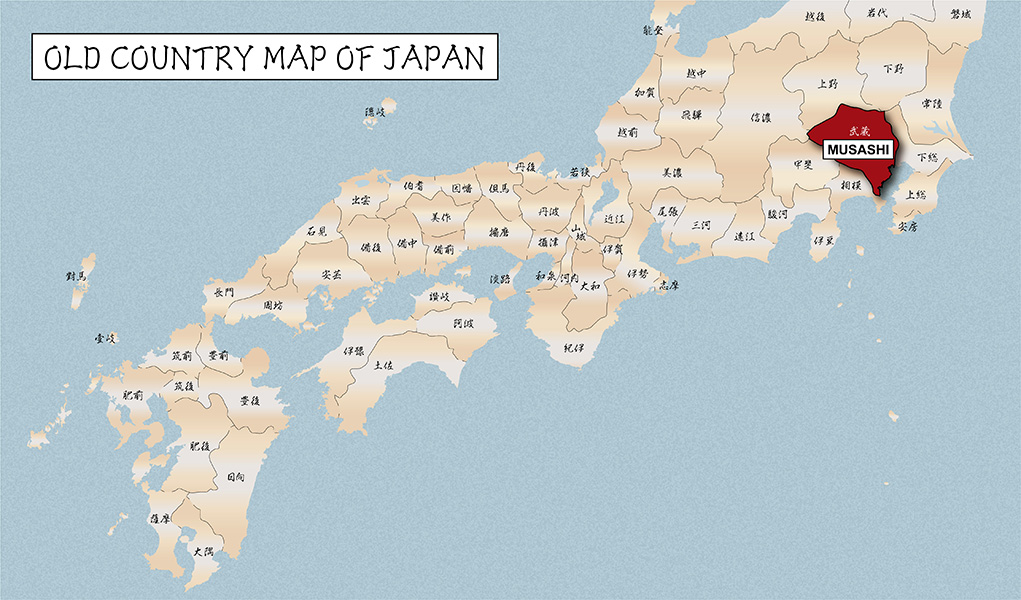
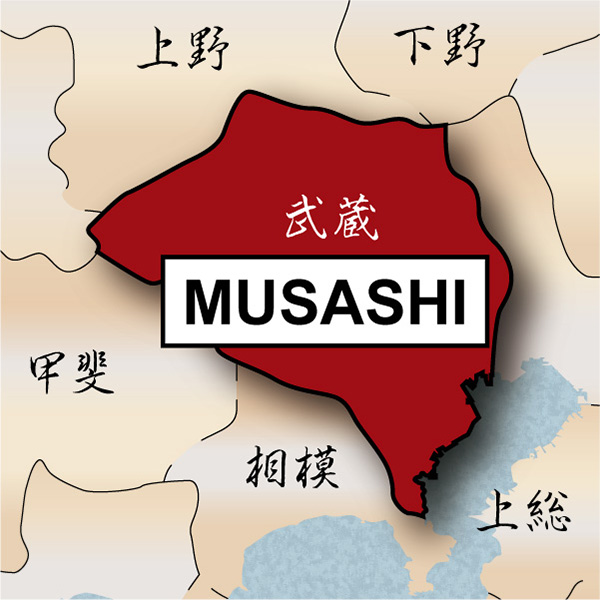
Suishinshi Masahide
Suishinshi Masahide (水心子正秀, 1750–1825) played an essential role in reshaping the sword-making world of the late Edo period.
During his time, mainstream Japanese swords had become straighter and less robust compared to the masterpieces of the Kamakura era. By studying ancient swords, Masahide felt that something was lacking in contemporary blades. He therefore announced the Token Fukko Ron (Revivalist Sword Theory), declaring that swordsmiths should return to the old ways of forging. This theory deeply resonated with sword makers of the time and eventually became the mainstream of sword-forging.
Masahide also wrote about ten books on swordsmithing and passionately trained many apprentices. Among his most famous students were Chounsai Tsunatoshi and Taikei Naotane, both of whom became renowned masters in their own right. His profound influence made him a central figure of the late Edo revival movement. He is counted as one of the Edo Sansaku (Three Great Edo Masters), together with Taikei Naotane and Minamoto Kiyomaro.
In his biography, Masahide stated that he had forged 369 swords during his career. However, only about 100 of them have been identified in Japan today, most of which are wakizashi. It is extremely rare to find a katana signed by him, making such works highly valuable and historically significant.
About late Edo period
The Bakumatsu period (幕末) was the final part of Japan’s Edo period, lasting from around 1853 to 1868. It began when American ships led by Commodore Perry arrived in Japan and encouraged the country to open its ports to international trade. This moment was a turning point in Japanese history. Many people in Japan were surprised by Western technology and started thinking about how the country should respond to the changing world.
At the time, there were strong debates between those who supported the traditional Tokugawa shogunate and others who believed Japan needed to modernize and return political power to the Emperor. These disagreements eventually led to conflict and the end of samurai-led government.
Samurai were important figures during the Bakumatsu period. Their swords, known as Katana, were not just weapons but also powerful symbols of their values and way of life. However, as Japan began to build a modern army and adopt new weapons, swords became less common in battle.
It is appraised as a Tokubetsu Hozon Token (特別保存刀剣) issued by NBTHK (Nihon Bijutsu Touken Hozon Kyokai:日本美術刀剣保存協会). This authentication paper was only given to authentic Japanese swords, especially well preserved and high quality with artistic value.
*Please keep in mind that there is a couple of Kitae Kizu on the Mune. If you like to know the detailed condition, please feel free to contact us.
【Blade】
Cutting Edge Length(Nagasa):74.8 cm (29.4 inches)
Curvature(Sori):2.0 cm (0.78 inches)

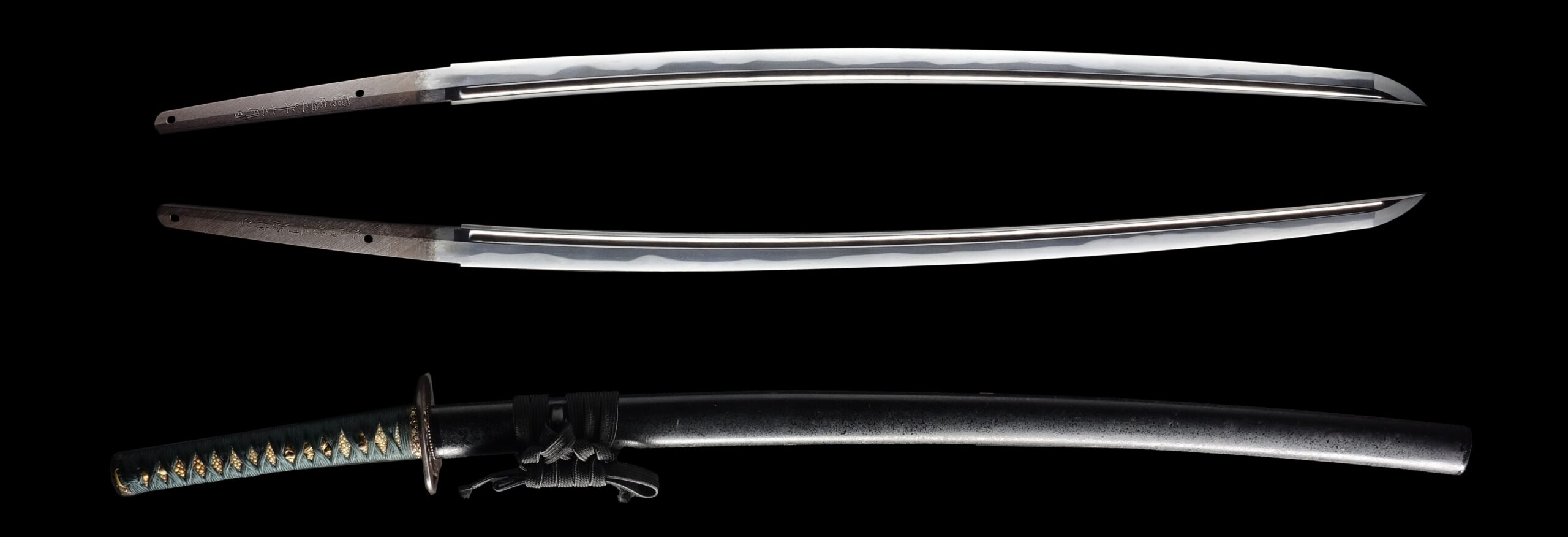
Hamon:
The crystalline structure which forms along the cutting edge of a blade as a result of the hardening process
Jimon(Jihada):
visible steel surface pattern created by folding and hammering during forging process
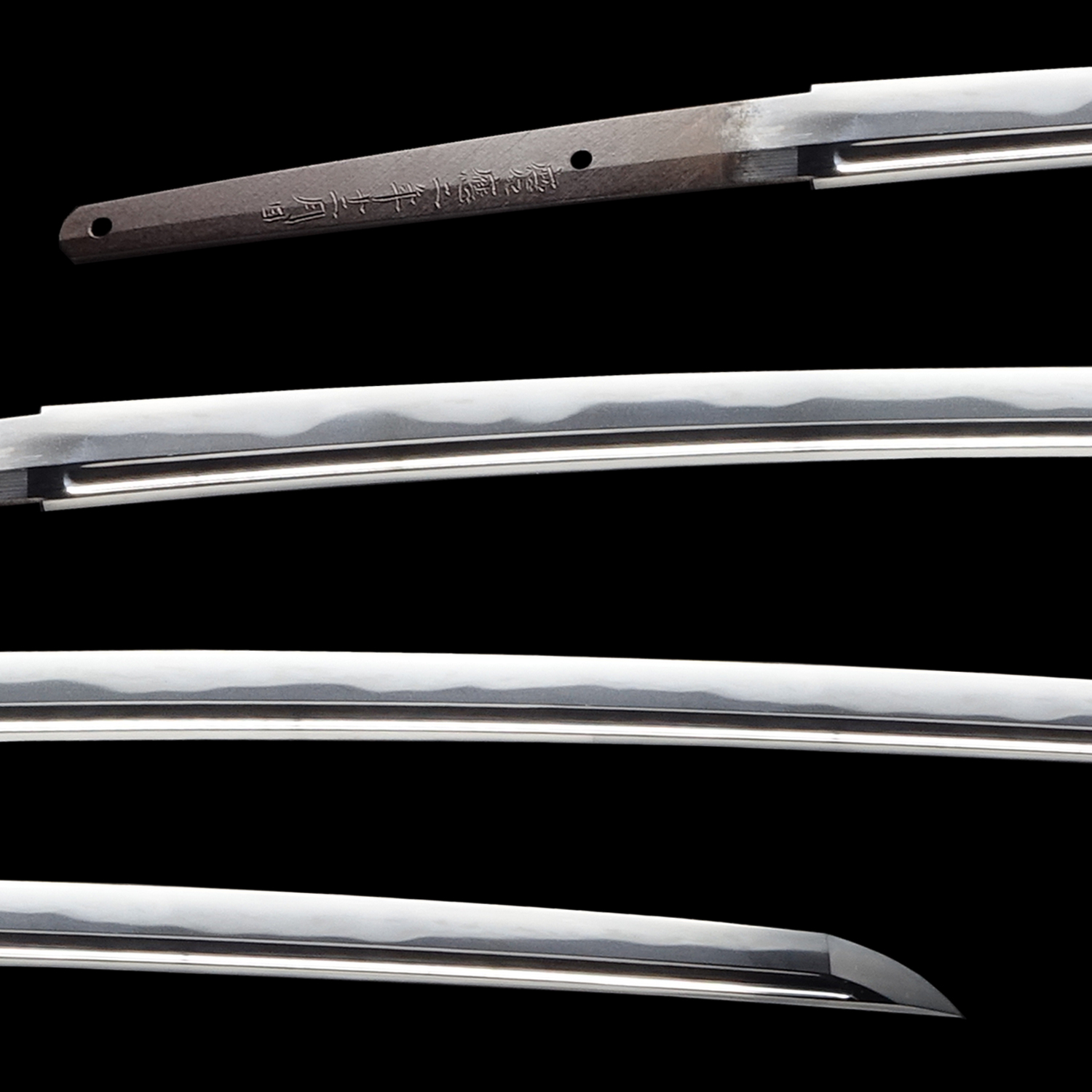
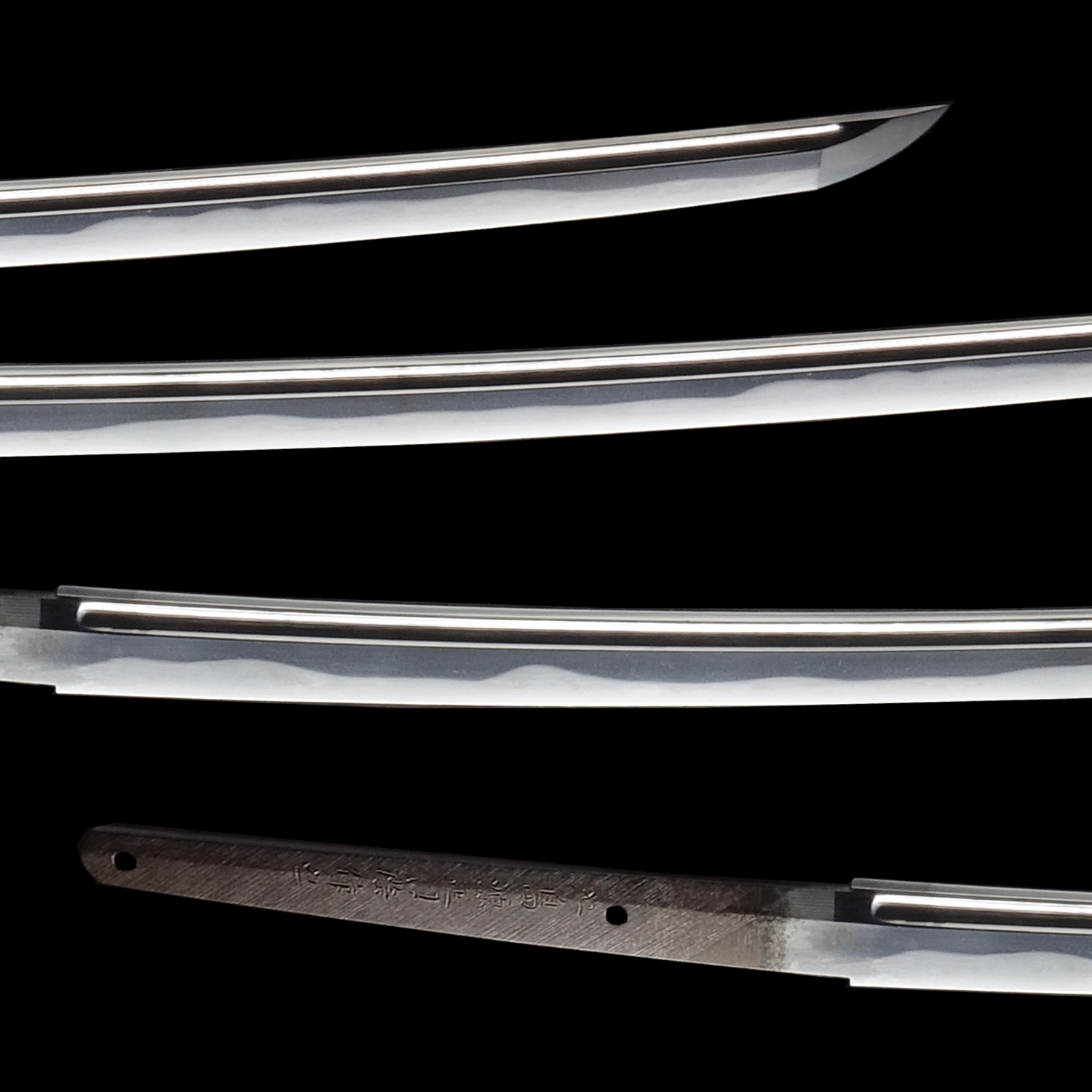
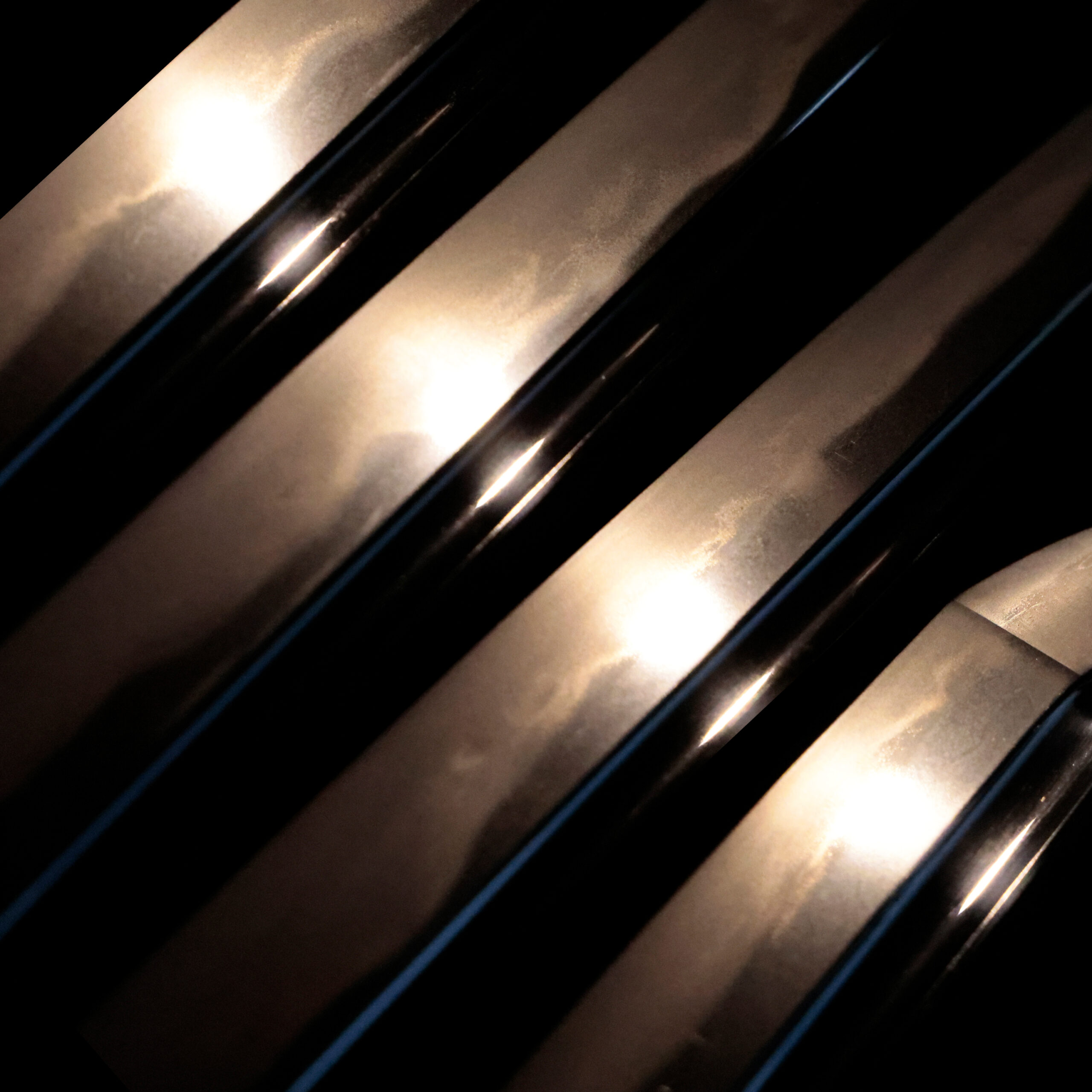
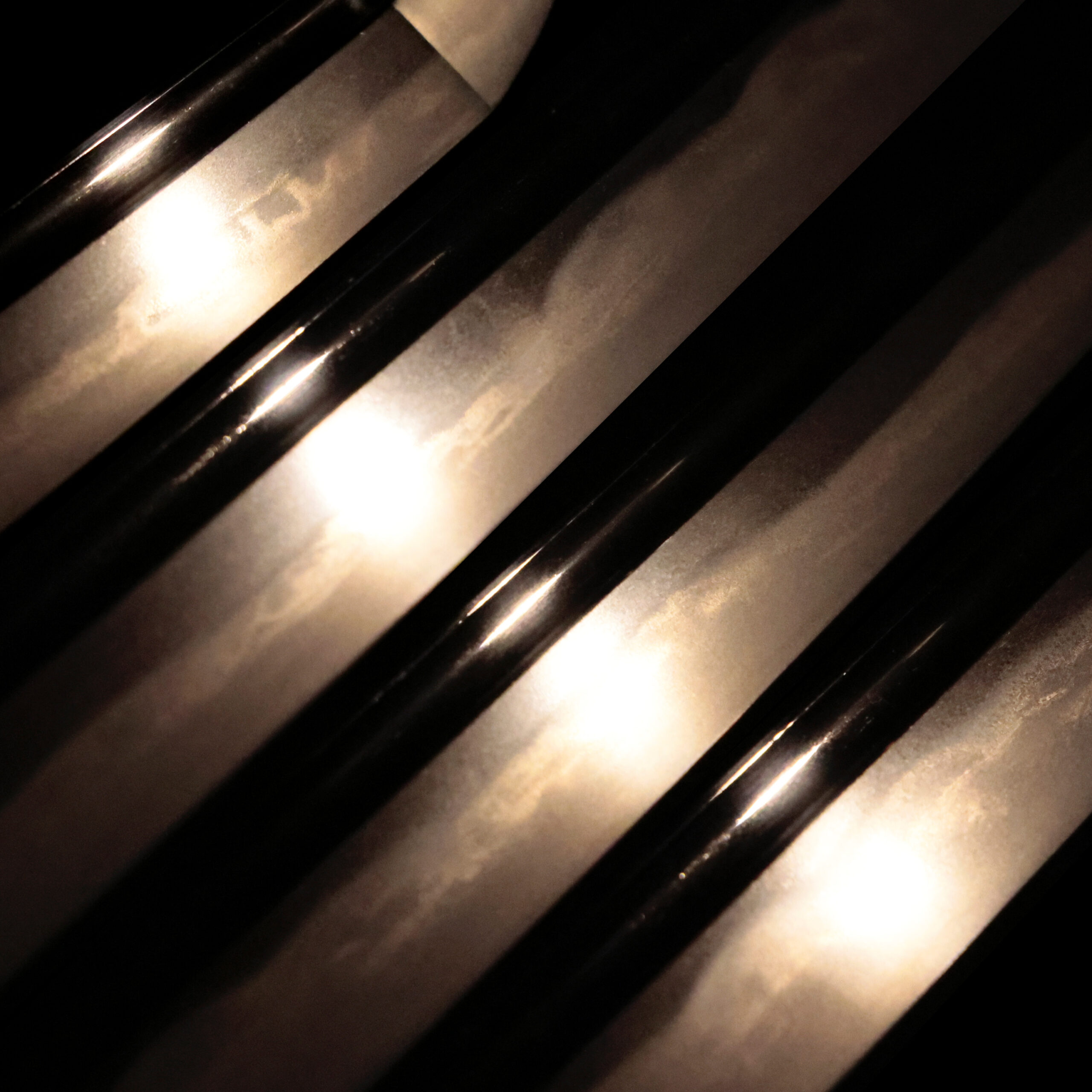
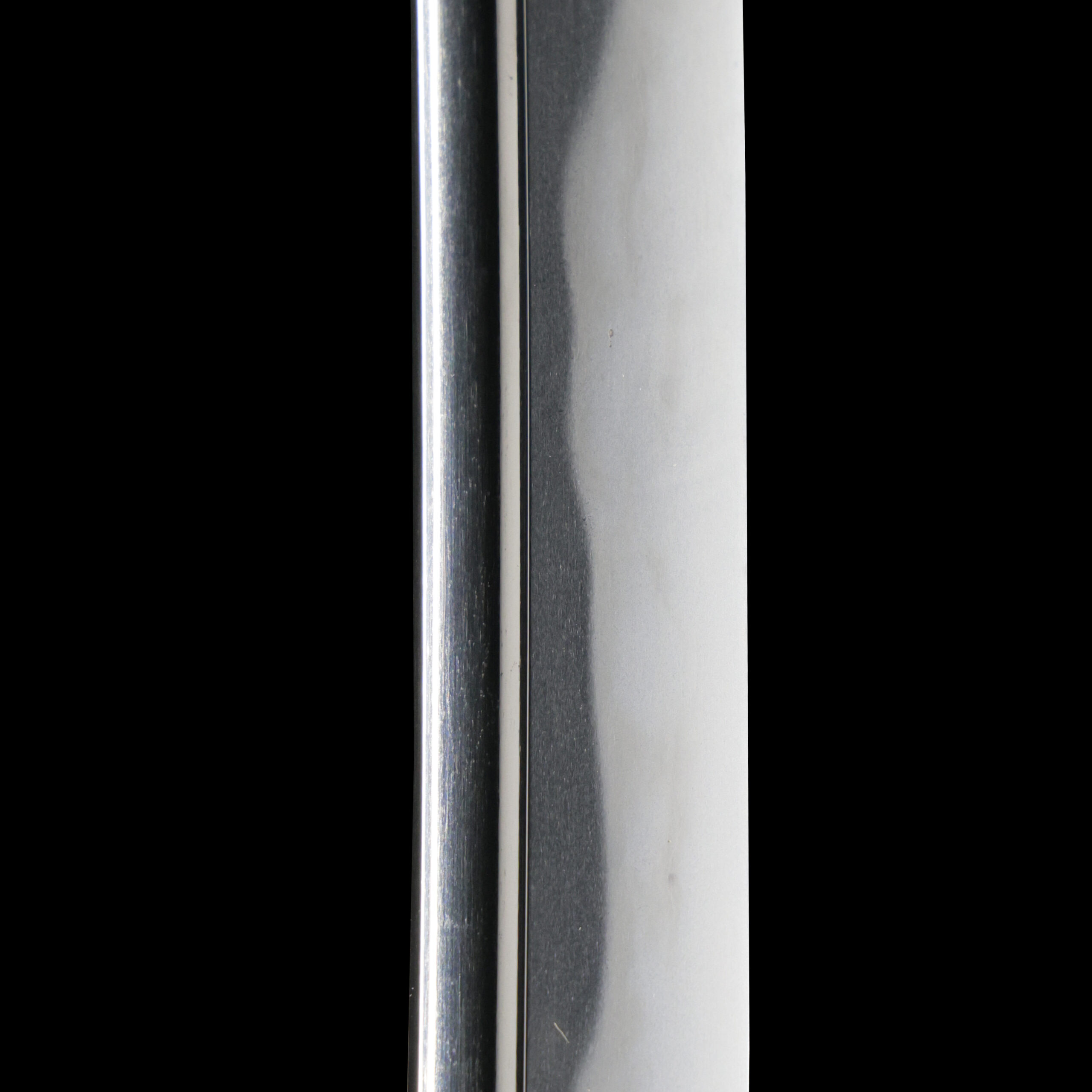
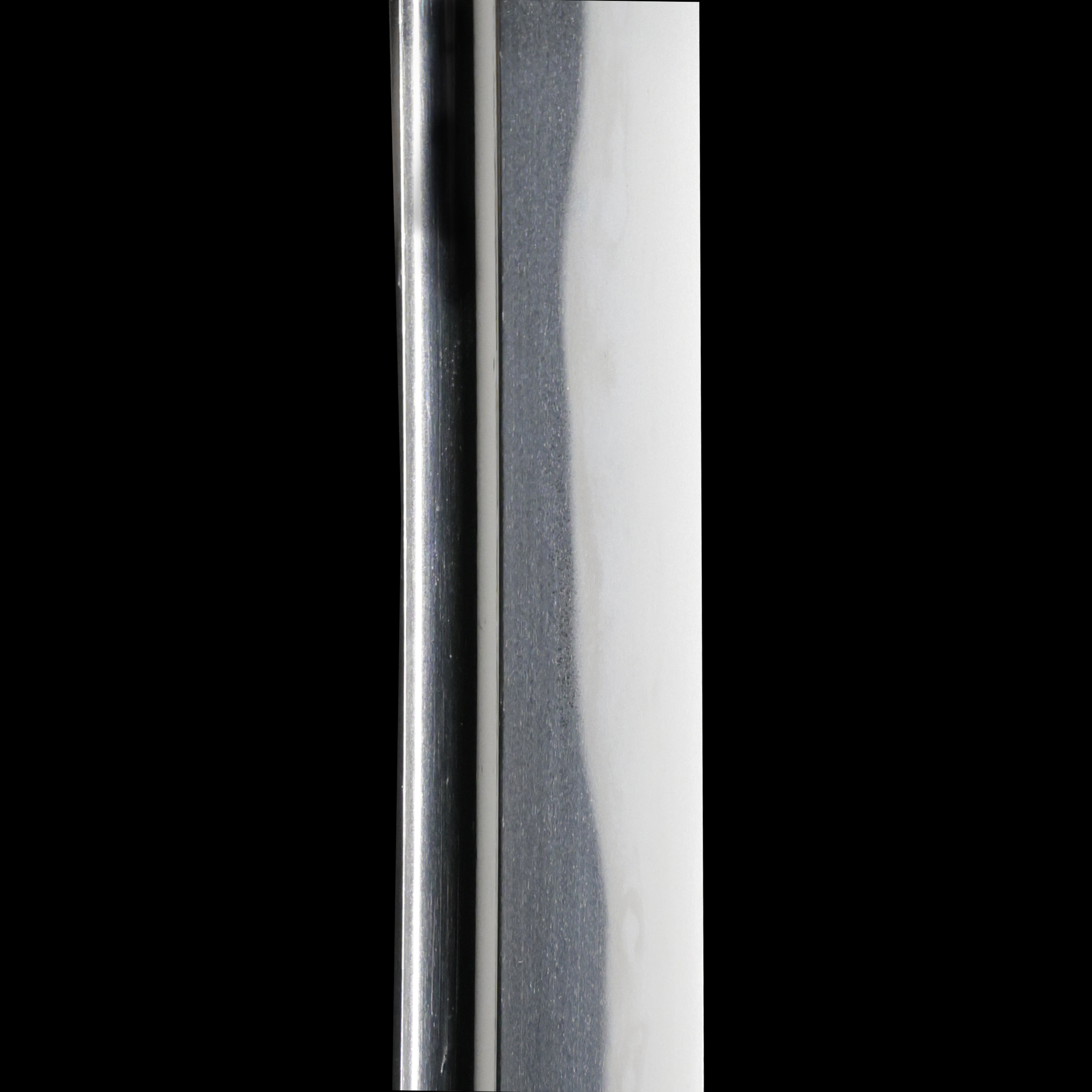
Kissaki:Kissaki is the tip of the Japanese sword.
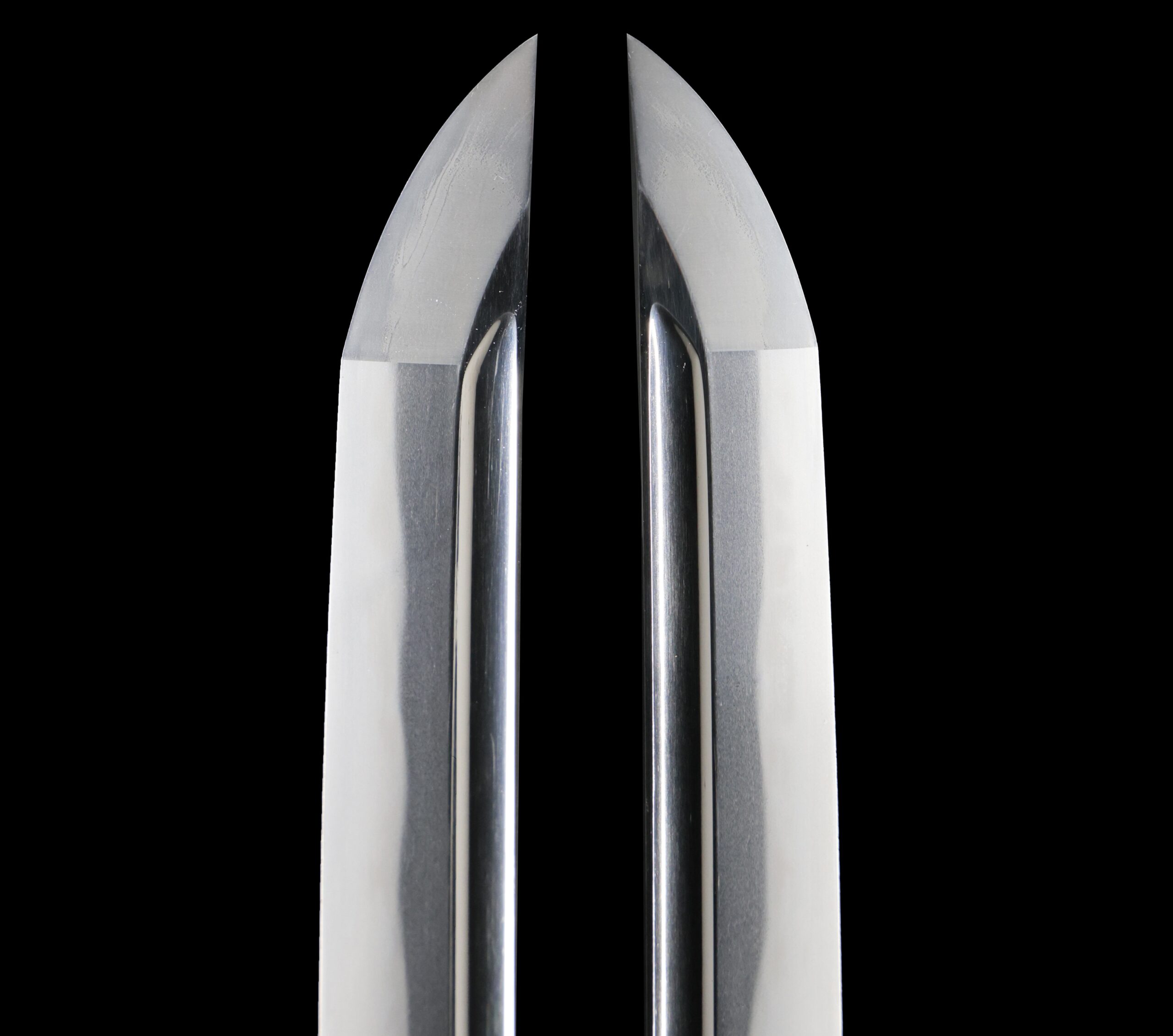
Nakago:Nakago is the tang of the Japanese sword.
Japanese swordsmiths left the black rust on the tang because it prevents red rust while the tang is in its handle. And the discoloration of the tang was created over time, and it is a great indicator for a Japanese sword specialist to estimate when the sword was forged.
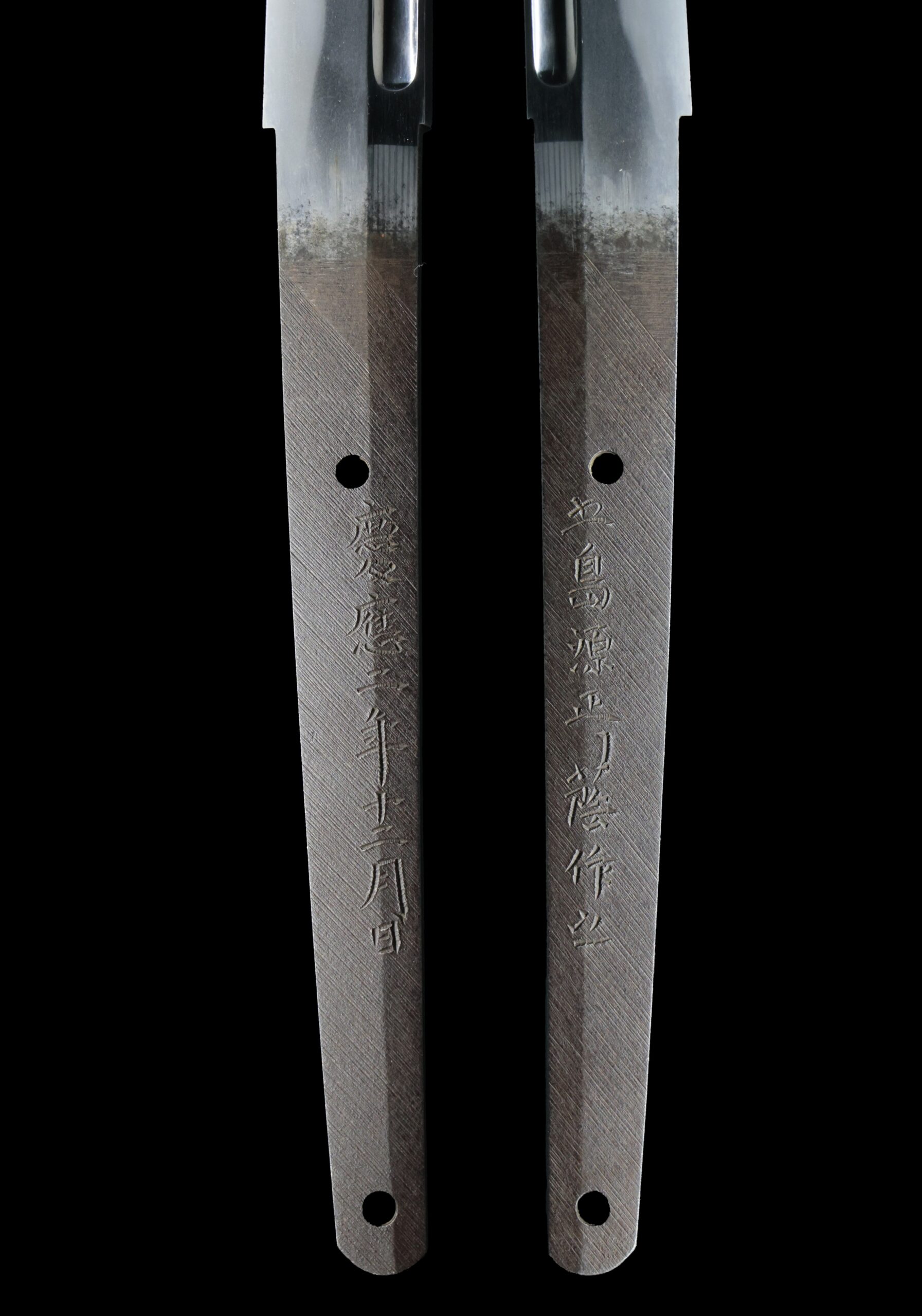
Koshirae:Koshirae is the mounting of the Japanese sword. There are several parts that consist of Koshirae such as Saya (Scabbard), Tsuka (Handle), Tsuba (Handguard).
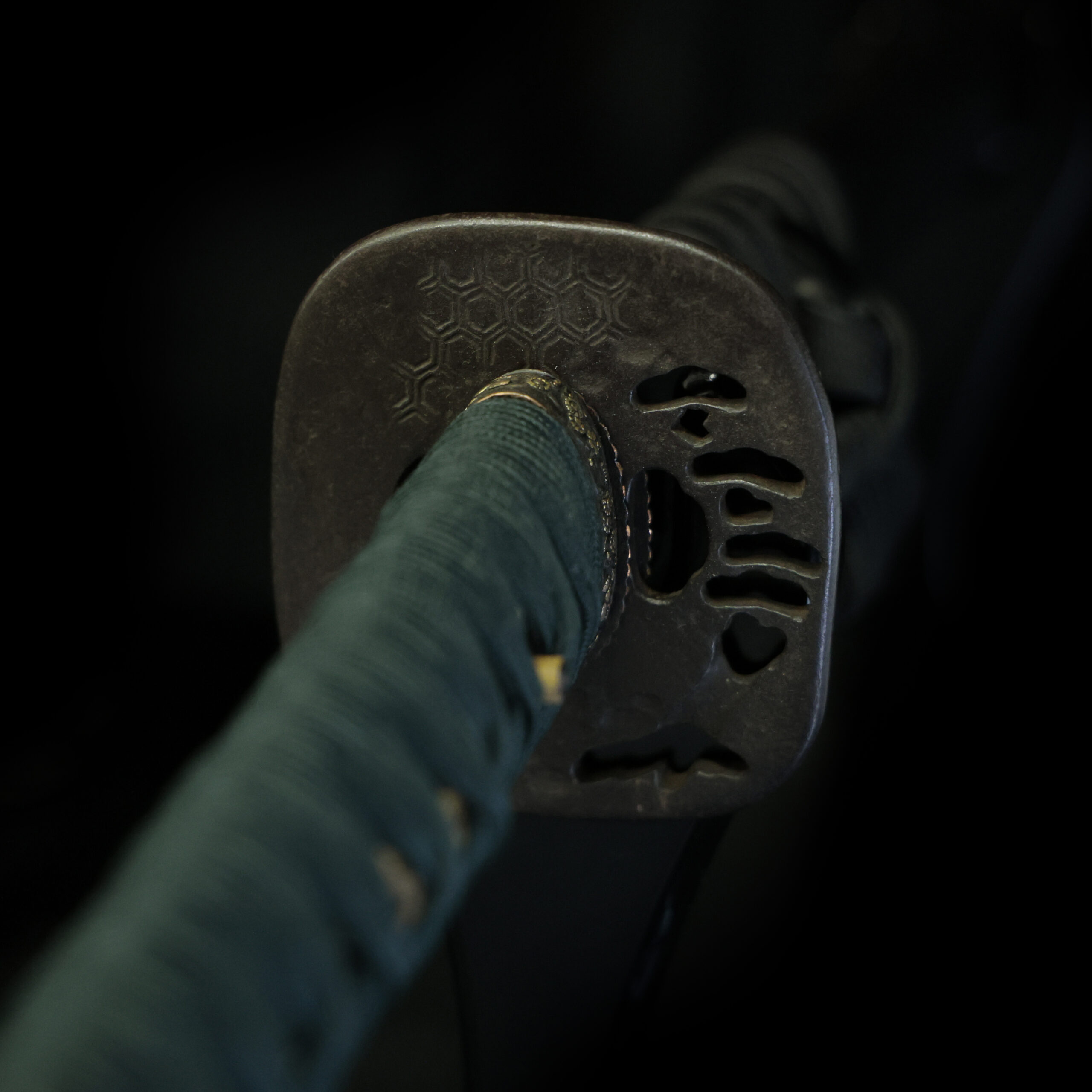
Fuchi-Kashira:A pair of matching sword fittings that cover the upper and bottom parts of its sword hilt.
The motif of this Fuchi-Kashira appears to represent the “Seven Flowers of Autumn” (秋の七草, Aki no Nanakusa), delicately expressed in fine gold inlay. In Japanese culture, the Seven Flowers of Autumn are deeply associated with classical literature and poetry, especially the Manyoshu (the oldest anthology of Japanese poems). They were admired not for eating but for their beauty and for the way they symbolize the seasonal transition from summer to autumn. By adorning sword fittings with such motifs, samurai not only enjoyed their refined aesthetic but also carried with them symbolic wishes for resilience, purity of spirit, and dignity in life.
The tradition of admiring the Seven Flowers of Autumn was a form of seasonal appreciation. In ancient Japan, people would stroll through flower fields and compose poems (waka and haiku) inspired by their beauty. The origin of this custom is attributed to two poems by the Nara-period poet Yamanoue no Okura (660–733), which are preserved in the Manyoshu. From these verses, the appreciation of the Seven Flowers of Autumn became an enduring part of Japanese seasonal culture.
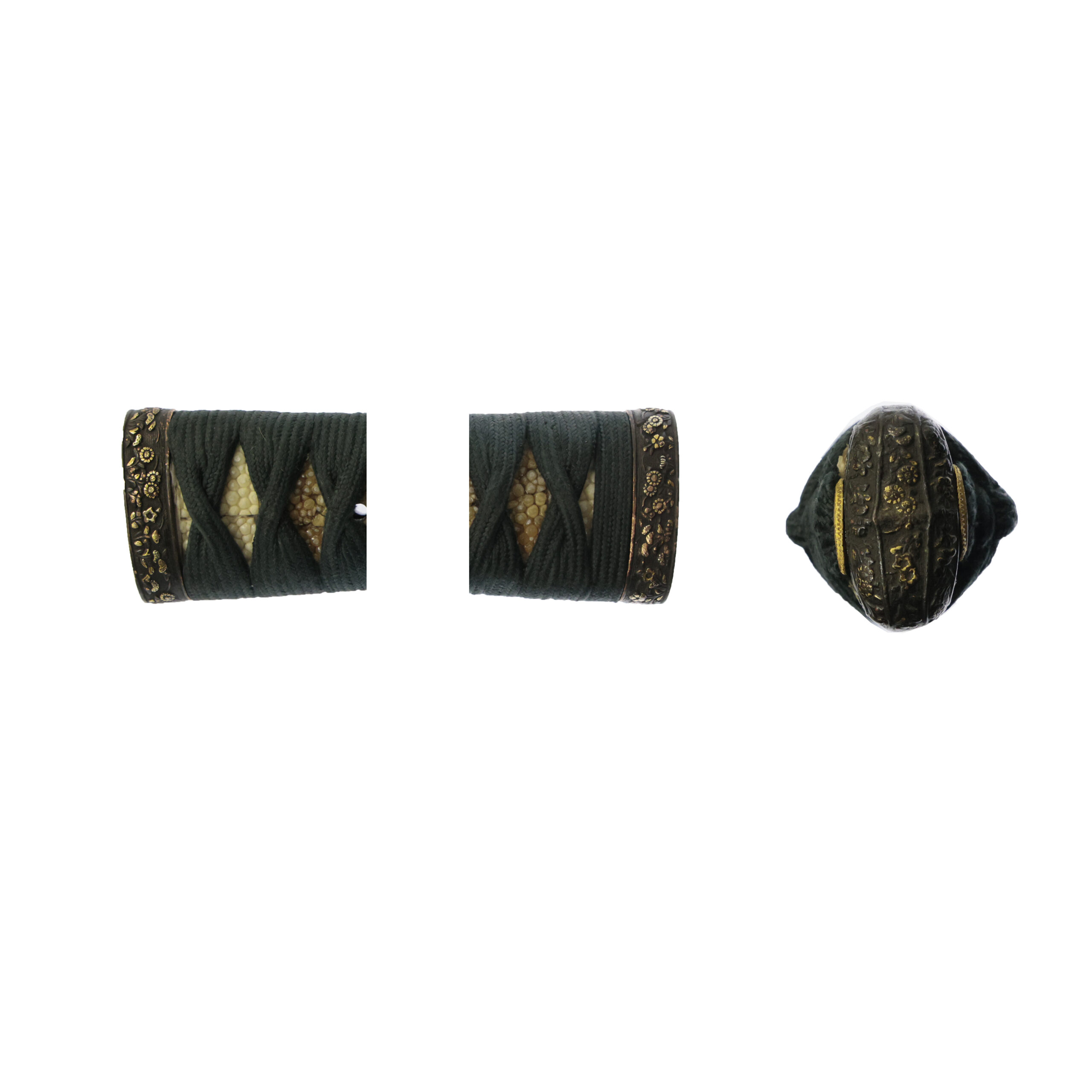
Tsuka and Menuki:Tsuka is the handle of the Japanese sword and Menuki is its decoration.
The motif of this Menuki is a dragon (龍, Ryū).
The dragon was originally an imaginary creature from ancient Chinese traditions and myths. It is considered a symbolic beast of auspicious signs. Its body is described as a combination of nine animals: antlers of a deer, the head of a camel, eyes of a demon, the neck of a snake, the belly of a Mizuchi (a Japanese mythical creature resembling a horned, four-legged serpent), scales of a fish, claws of a falcon, palms of a tiger, and ears of a cow. Because of this extraordinary form, the dragon was believed to reign at the top of all creatures.
In ancient China, dragon motifs were used exclusively for the emperor’s clothing, with strict rules regarding the design and even the number of claws. In Japan, however, such rigid regulations did not exist, and the dragon motif was widely used while still retaining its meaning as an all-purpose auspicious design.
In addition, in Japan the dragon is also revered as a water deity, known as Ryūjin Shinkō (竜神信仰). Since rice cultivation has always depended on water, the dragon became a familiar and powerful symbol deeply connected to Japanese life and culture.
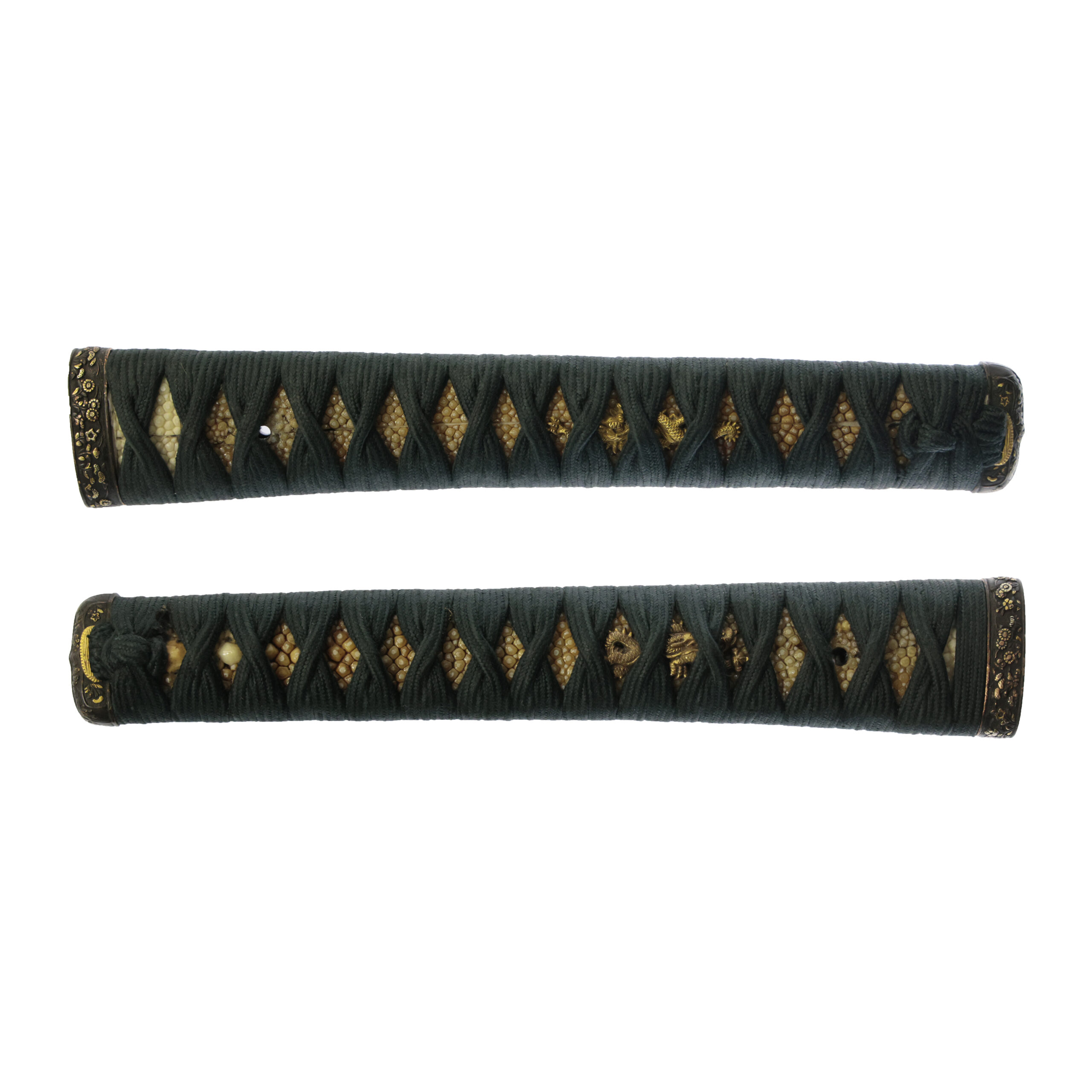
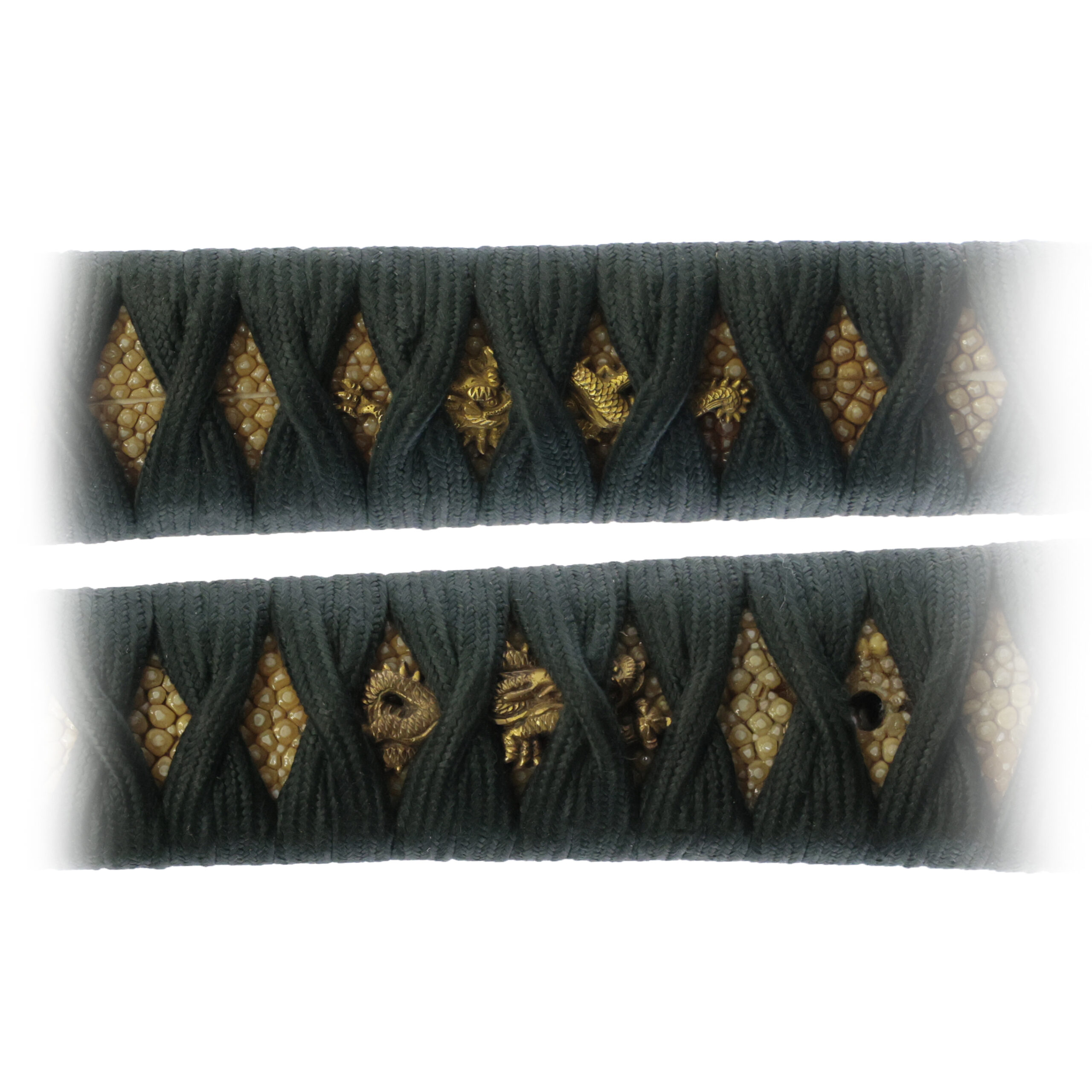
Tsuba and Habaki:Tsuba is the handguard for the Japanese Sword and Habaki is the equipment to make the blade not touch its scabbard inside. It prevents the blade from getting rusty and chipped.
The design of this tsuba features a hexagonal geometric pattern crafted using the technique known as sukashi-bori (透かし彫り, openwork carving). Sukashi-bori involves cutting through the surface of the metal to create open spaces, allowing a hard material like iron to be expressed in a delicate and airy form. Light and shadow interplay through the openings, producing a striking visual effect. Beyond its decorative appeal, this technique also served practical purposes, such as reducing the overall weight of the guard and distributing structural stress during use.

Saya:Saya is the scabbard for the Japanese sword.
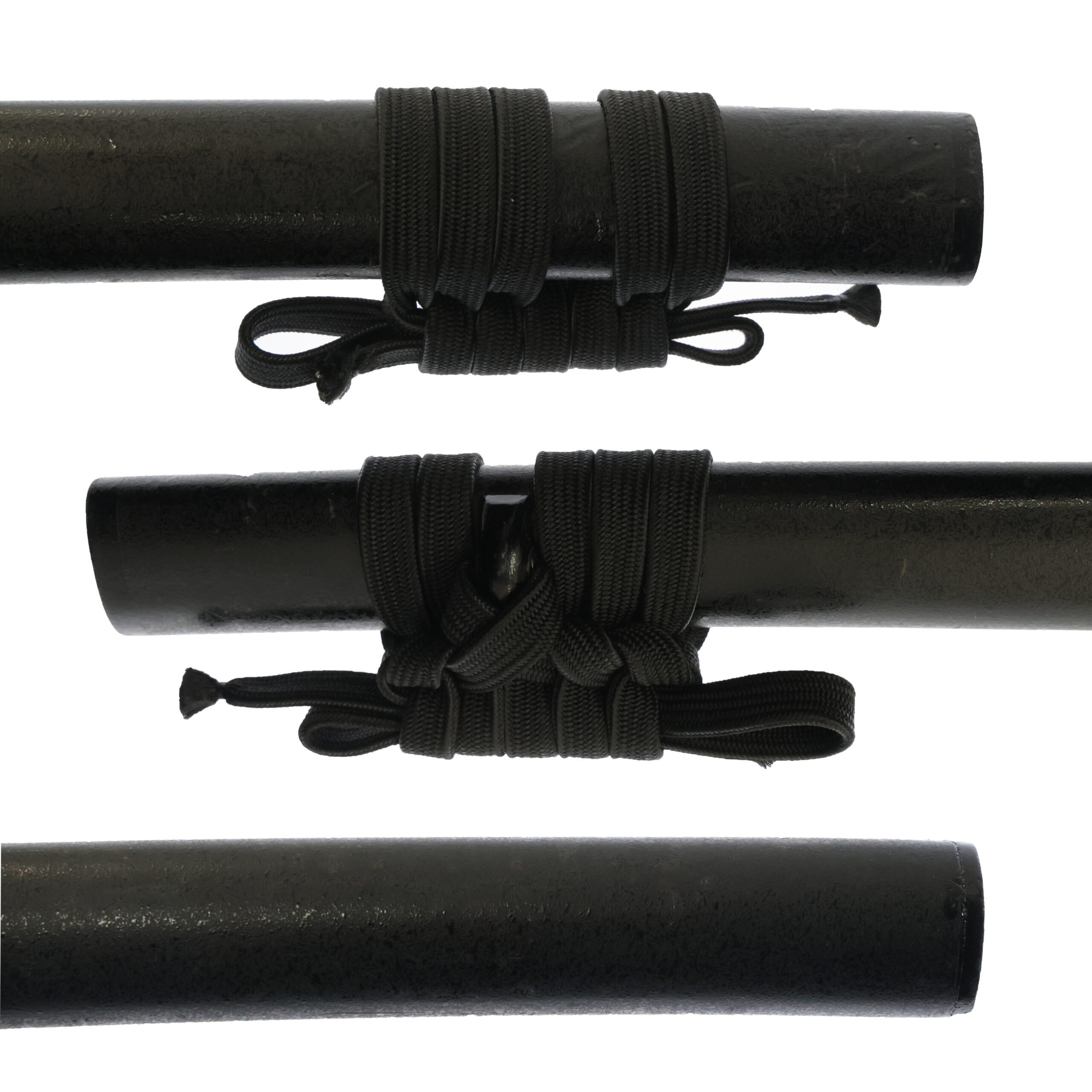
Authentication Paper:NBTHK TOKUBETSU Hozon Certificate for the blade (No. 1020068)
NBTHK, also known as Nihon Bijutsu Touken Hozon Kyokai (the Society for the Preservation of the Japan Art Sword), is one of the oldest Japanese sword appraising organizations in modern-day Japan. They authenticated the blade on March 10th in the 5th year of Reiwa (2023). They appraised it as Tokubetsu Hozon Touken, the blade especially worth preserving for Japanese society. The purchaser will receive this original certificate as well. We can also translate what is written into English and make a PDF file for your record if you request.
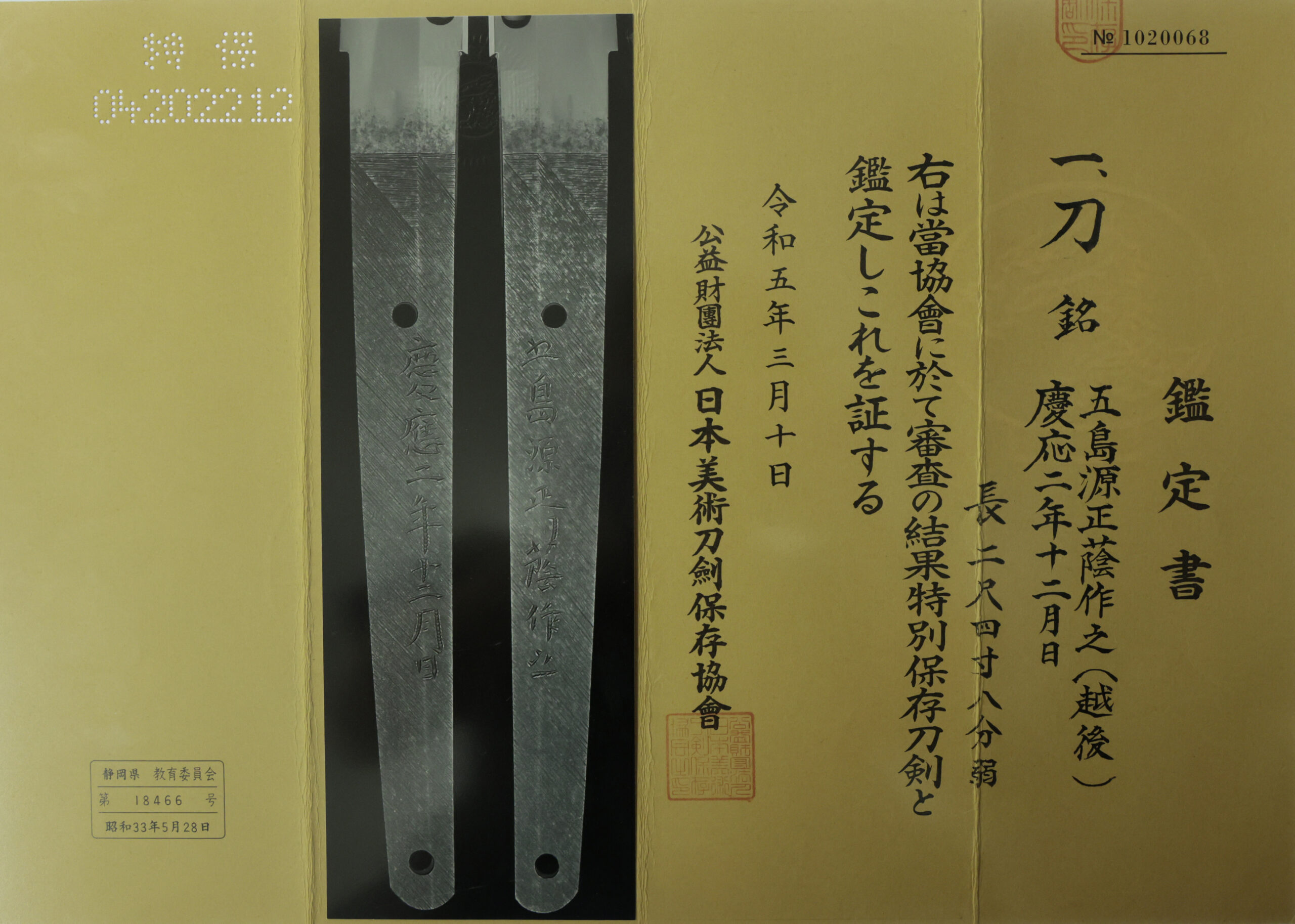
Registration Number : Shizuoka 18466
The Board of Education in Shizuoka prefecture issued a registration paper for this sword. It is called Jyu Hou Token Rui Tourokusho (銃砲刀剣類登録証). Bunkacho (The Agency for Cultural Affairs) acknowledges a Japanese sword with this paper as a work of art.
The sword needs to be traditionally hand-forged and made of Tamahagane carbon steel to be registered in the system. With this paper, its owner in Japan can legally own an authentic Japanese sword. Based on this registration number, we will apply for its export permit.
This paper will need to be returned to the board of education when the sword is being shipped abroad, but you can receive a copy of it. An English translation of this registration paper is available on request.
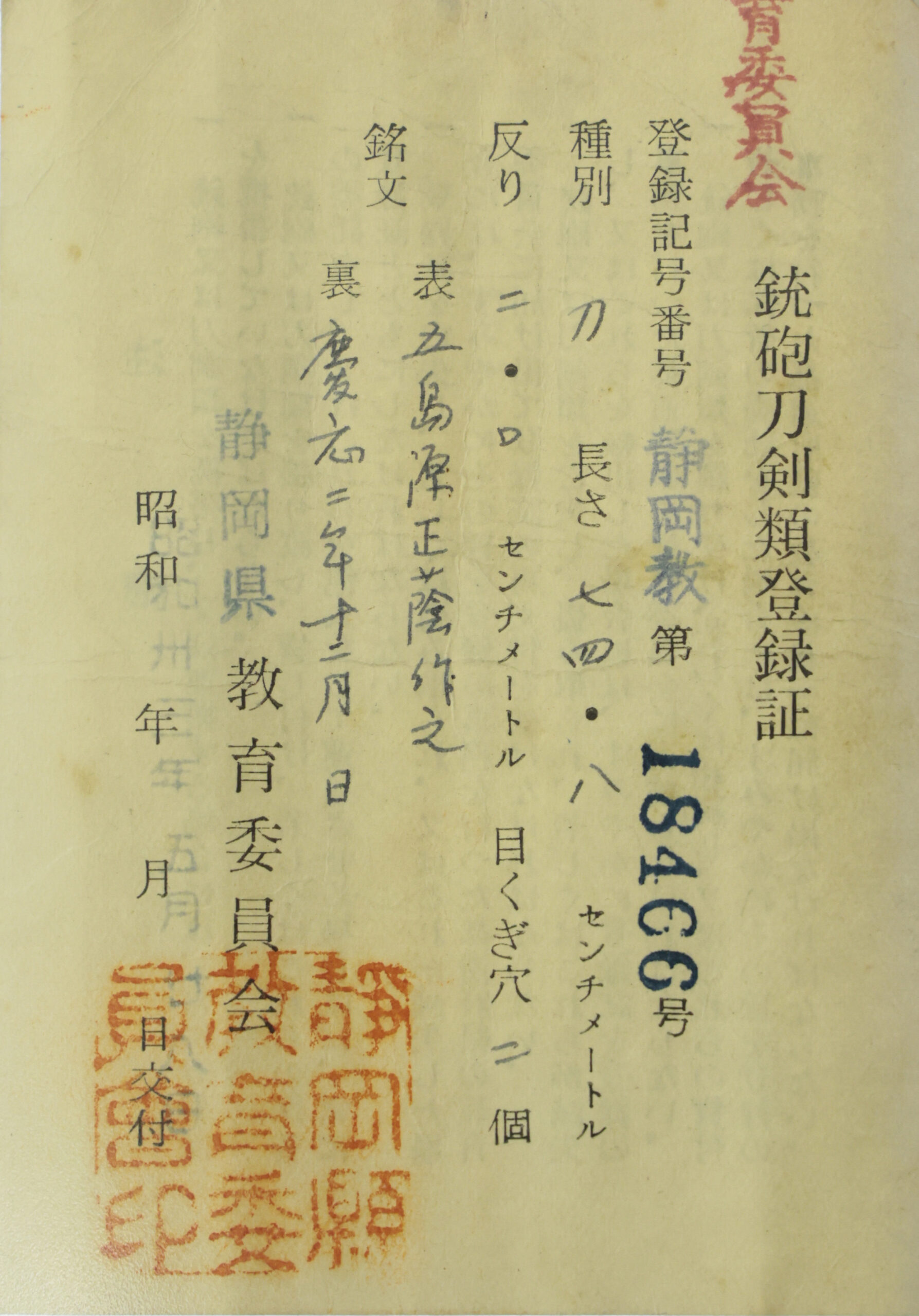

—————————————————————–
【About us】
Samurai Museum is located in Tokyo, Japan, exhibiting antique artifacts related to the Samurai history. Samurai Museum Shop is the place for those who are interested in Japanese culture and craftsmanship. We deal with antique Samurai swords/armor, traditional crafts made in Japan and so on.
【Japanese Sword& Export Process】
The Japanese swords we deal with are hand-forged edged swords made in Japan. It was made from the traditional carbon steel called TAMAHAGANE(玉鋼). Samurai Museum is familiar with the proper legal procedure for an antique/ authentic Japanese sword to be exported from Japan. We have sent more than 1000 Japanese swords for the past few years (~2025) to amazing owners who appreciate its historical value.
Each Japanese sword is registered under the Agency for Cultural Affairs and the Board of Education in Japan. They issue a registration paper for each Japanese sword for its owner in Japan to legally possess it. The Japanese sword with its registration paper means it was traditionally hand-forged in Japan.
To legally export the sword from Japan to other countries, we will have to apply for its permit to the Agency for Cultural Affairs(Bunkacho) and return the original registration paper to the Board of Education. It normally takes around 2-4 weeks to receive this permit after submitting required documents. And we would like you to expect at least 1-1.5 months for your order to arrive at your given address after you ordered. For more detailed info, please click here.
It is allowed for residents in Japan to own authentic Japanese swords without a special license as long as they come with registration papers. Please feel free to contact us if you are a resident of Japan, whether temporarily or permanently. We will also assist you when you leave Japan and need to obtain the export permit.
【Payment Method】
We accept payment through Stripe (Credit card), PayPal, Apple Pay or ChromePay, all of which are secure payment methods. Also, you don’t need to make an account on Stripe for the checkout. If you prefer other payment method, please contact us. After confirming your payment, we will apply for an export permit. You may either pay in JPY, USD, AUD, CAD,EUR CHF or GBP. The price is set in Japanese Yen. Prices in other currencies are automatically calculated based on the latest exchange rate.

* If the amount is above 1 million JPY, Stripe or wire transfer will be the only options for payment.
【Shipping】
We have shipped authentic Japanese swords to the USA, Canada, Mexico, Germany , Belgium, France, Finland, UK, Hong Kong, Australia. If you don’t live in these countries and like to order, please contact us first before making a purchase. We offer Free International Shipping as long as we can send antique Japanese swords by EMS.
We normally ship by EMS(Express Mail Service) provided by Japan Post. We will send you a tracking number for your order as soon as we hand it to the post office. We will put 100 % insurance on the shipping document without any extra charge. Based on the total amount, there might be a duty tax or other fee for you to pay, depending on the countries. We use package cushioning to protect the item and put it in a PVC pipe, which is one of the most secure packages because of its durability.
It will normally takes 5-14 days for the item to arrive at your given address after we dispatch it. Time of delivery is estimated as accurately as possible by the carrier but does not take into account any delays beyond our control such as by inclement weather, post office holiday seasons.
* If you live in Australia and like to purchase an authentic Japanese sword, please click here to know the detail.
* If you live in the UK and like to purchase an authentic Japanese sword, please contact us first and click here to know the detail.

【Review】
Here is one of the reviews we received from a customer who purchased an authentic Japanese sword from us. For more reviews, please click here.
“My experience overall with the whole process was wonderful. I had many questions about the history and process to purchase these treasures. All my questions were answered very timely and complete. The staff is very knowledgeable and very well versed if any questions do arise.”
【How to make sure the condition】
Please keep in mind that what you are going to purchase is an antique item. We uploaded high resolution photos for you to check its condition thoroughly. If you like to see more photos with different angles, please feel free to contact us. We will be happy to send them to you so that you can make informed decision. It is essential for us to know that you are happy with your choice of a sword. and we are prepared to use the best of our ability to serve you.
【How To Contact Us】
Please contact us through email, Facebook Messenger or Live Chat if you have any questions. You can find each icon on the right side of the website. Please click one of them to reach us. We will reply to you within 1-2 business days.
【The Art of Nihonto (Japanese Sword)】
Samurai’s history is a profound, eloquent legacy of ancient Japanese warriors in which millions of people worldwide are being fascinated. If you like to find out the art of Nihonto, please click here.
【A Guide to Japanese Sword Maintenance】
After acquiring an genuine Japanese sword, it is also important to know how to take good care of it. Here is the special video for you. Mr. Paul Martin, Japanese sword expert, shows you how to give proper maintenance to your sword. By mastering how to clean the Japanese sword, its aesthetic beauty will last forever.
When you purchase a Japanese sword from us, you can get a Free Japanese sword maintenance kit. It comes with four tools(Choji Oil, Uchiko Whetstone Powder, Peg remover, Oil Applicator). By watching the video instruction above , you can enjoy learning how to maintain your Japanese sword while appreciating it. If you have any difficulty assembling the sword or cleaning the blade, you can feel free to contact us.
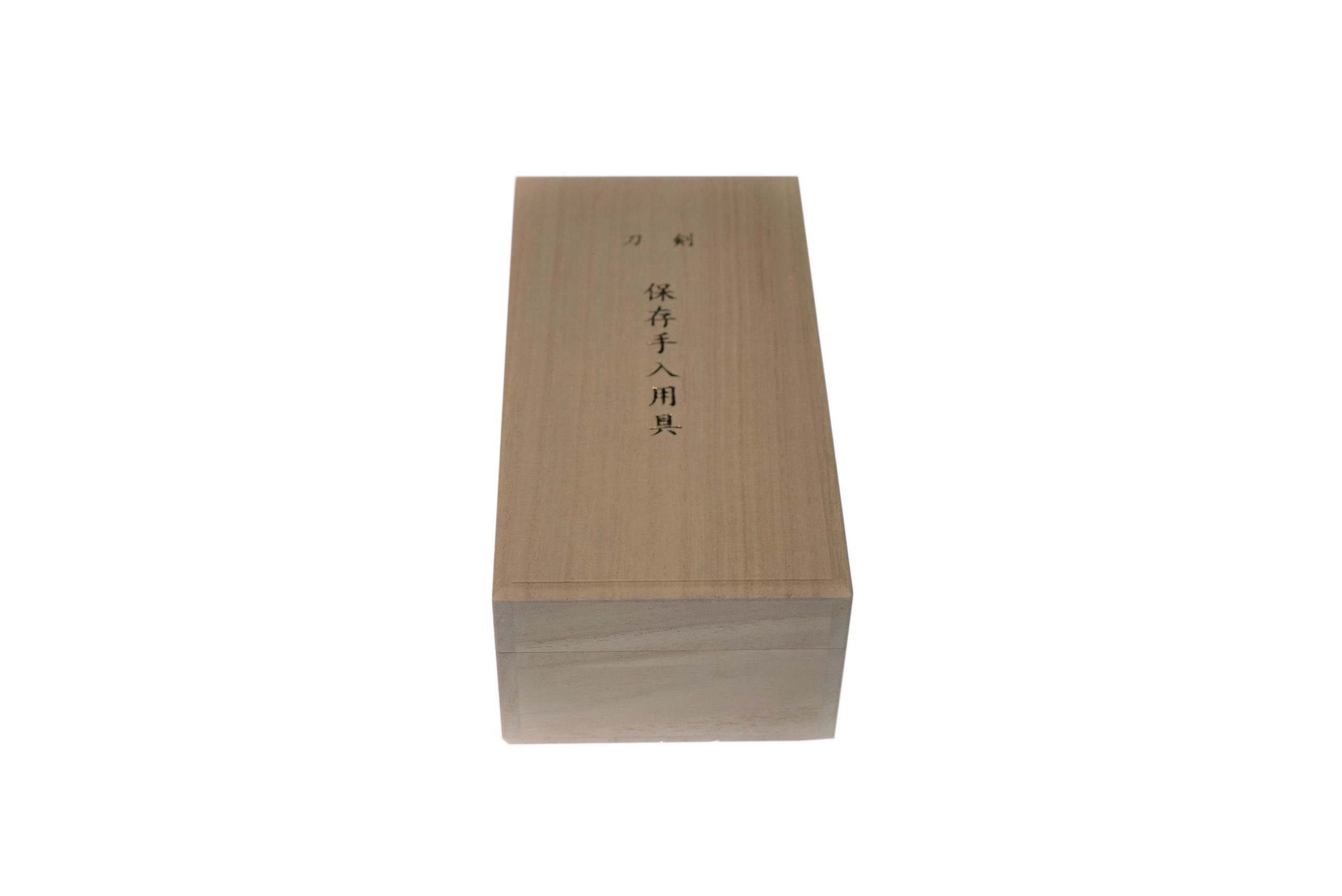
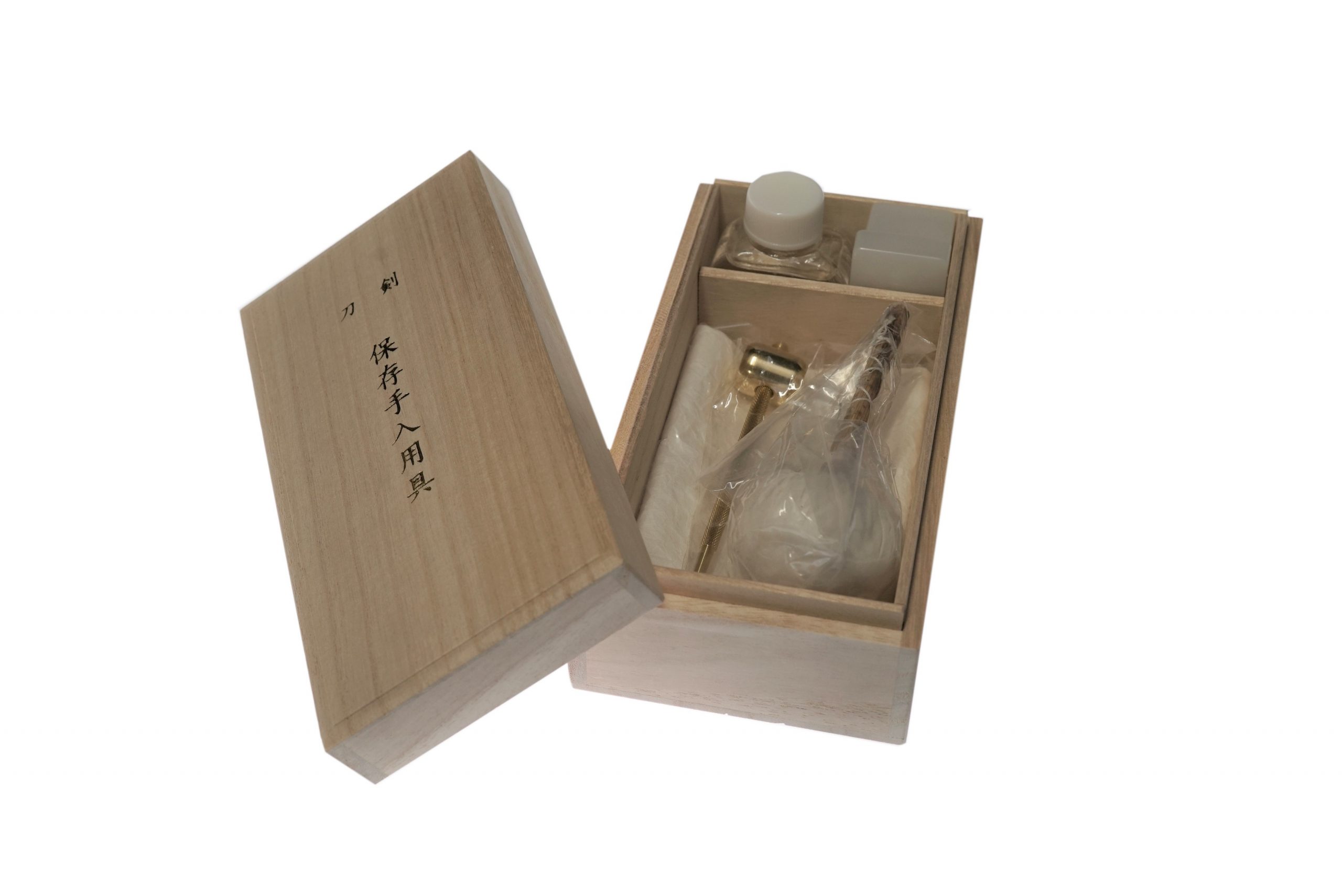
MORE ANTIQUE JAPANESE SWORD FOR SALE
SWORDS WITHOUT CERTIFICATES FOR SALE
LEARN JAPANESE SWORD TERMINOLOGY
Thank you for reading all the information on the page. If you have any difficulty choosing the right Japanese sword for you, we will be more than happy to help you find the one that speaks to you the most. Please feel free to contact us.
